Theo Verelst Local Diary Page 44
I've ditched the usual header for the
moment, I think it doesn't help much anyhow.
This page is copyrighted by me, and may be read and transfered by any
means only as a whole and including the references to me. I
guess thats normal.
This
page is under contruction, so check back later, too.
Tue Jan 22 22:08, 2008
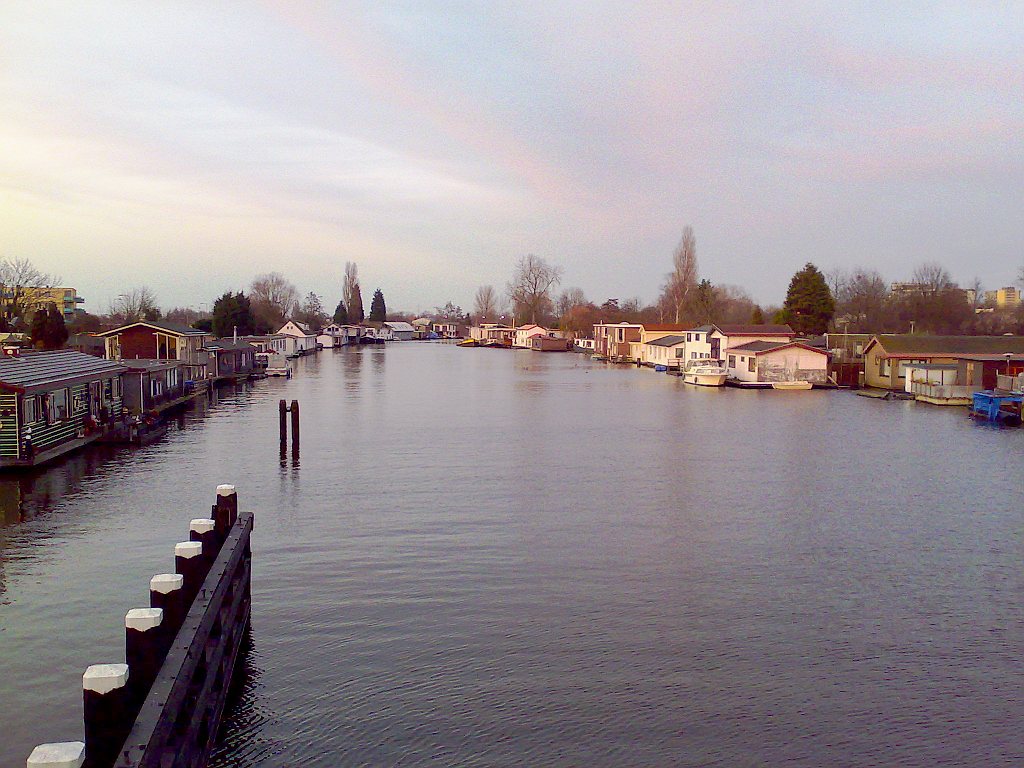
Moved
to Bay Area? Certainly not, I only wish! "This is Amsterdam man....".
Cute spot though.
I listened to a WBGO newyear webcast (it´s a New York radio
station with webfeed, which is member supported, and yes I made
somebody pitch in, too...) with the Count Basie orchestra in San
Francisco, which made me feel good.
The way I did that is fun, I used a Nokia Communicator (the new one) to
receive an internet webcast in realplayer form, which sounds pretty
good. In fact I used internet that way, too, because the server is
still where the internet currently is, in the new place there´s
no connection.
What, moving again? Nasty subject. In a way, at least I´m moving
allright. And the wireless internet from the phone works very fast in
fact, about the speed of the earlier Adsl I´ve used some years
ago, amazing, though maybe not so good for the local elektrosmog.
´Use with measure´ or something.
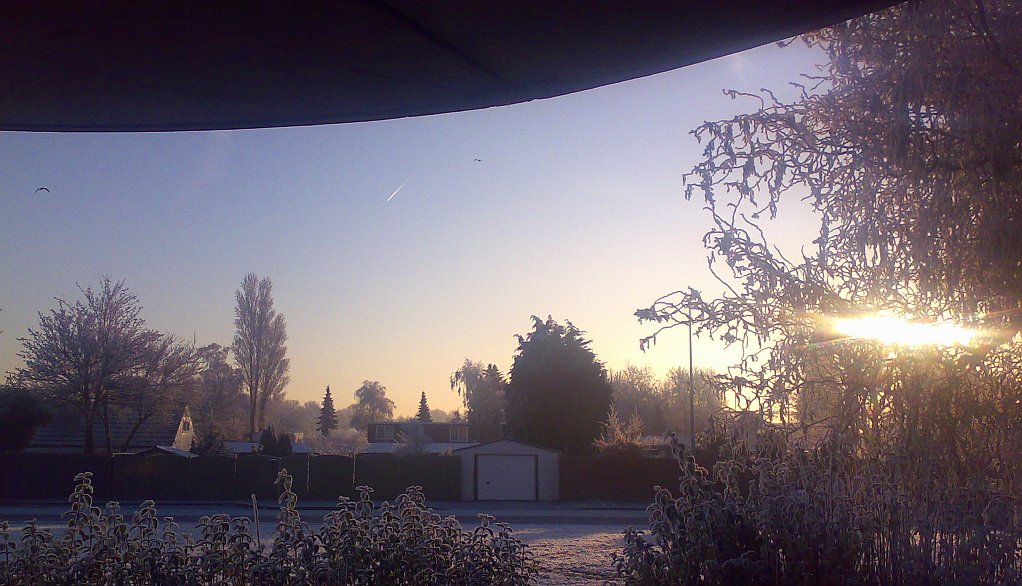
local view on a
wintermorning
As a added remark: of course when you´re reading and viewing this
page the server has come back on line! So the entertainment and
informing of interested people may continue.
Mixed pictures
So what camera(s) did you I for the recent pages? Well interesting
question, in fact I fully abandoned the HP 5 megapixel camera I made
thousands of pictures with and use two others: the Sony 2k High
Definition camera, and a Nokia communicator with 3 Megapixel camera. Of
course the Sony is the most Hifi camera, it can really capture a lot of
good light for a film or photo, or a photo from film (HD video) as I
often do. But the new Nokia has a very decent cam built in which does
more than a bit of those photographic ´optimisations´ such
that the photos look juicy and all.
I think it is a funny game to not say which processed picture like I show
mostly on these pages are from which of these two cams, so people can
guess. I like trying to get preferably a great number of classic and
recent photographic types of pictures so as to have a good palette of
choices instead of a camera precooking always a certain style.
So unless I mention it (but it is possible to look at the picture names
to get ideas) it is quite possible the images are processed, and in
some cases such that normal photoshop users would be lost to revreate
those effects, totally. And I mean I was a poweruser of Photoshop years
ago, and times even paid for it, so I know what I´m saying! And I
like currently (having no money) to use Open Source Software, and make
it myself for free,too, so that the results on these pages are most
likely processed by Cinelerra, Cinepaint (a recent linux version) or
Gimp, or a combination thereof. In some cases like processed frames
from HD I use first cinelerra for adaptive frame averaging (in 32 bit
floating point per colour component!), processing and saving of a HDR
(High Dynamic Range) TIFF image, subsequently cinepaint in 16 bit per
colour component mode for HDR quality processing like gamma correction,
and brightness control, sizing with bit accuracy improvement, and
possibly sharpening, of which the resized result is then saved in high
quality jpeg, which I feed through gimp to get a progessely coded jpeg
with quality versus size control. In other cases I simply use gimp
under windows to make a screendump from the high quality mode /
Purevideo accelerated windows media player (also a fairly recent
update) and save it in a fitting progessive jpeg accuracy.
Well, that´s where I was some time ago, the more advanced, but
not necessarily better processing would involve mixing amounts of
equalized image versions with the original, special effects (though
seldom), multilevel analysis and selective colour enhancements (also
using layers), and all of this preferably in HDR, or it soon becomes a
color quantisation hell (8 bits processing gives accumulated errors).
Oh I also tend to use curves to adjust brightness and contrast, but
since the HD cam I often prefer a hopefully correct amount of gamma
correction.
Magazine or book looks from the 70s, and general film impressions
(which require more accuracy than most monitors will give you) are
favorite effects of me to aim for. Though I don´t normally
introduce artificial grainyness, and am aware of the power of analog
processing of actual negatives as compared to even high resolution HDR
images...
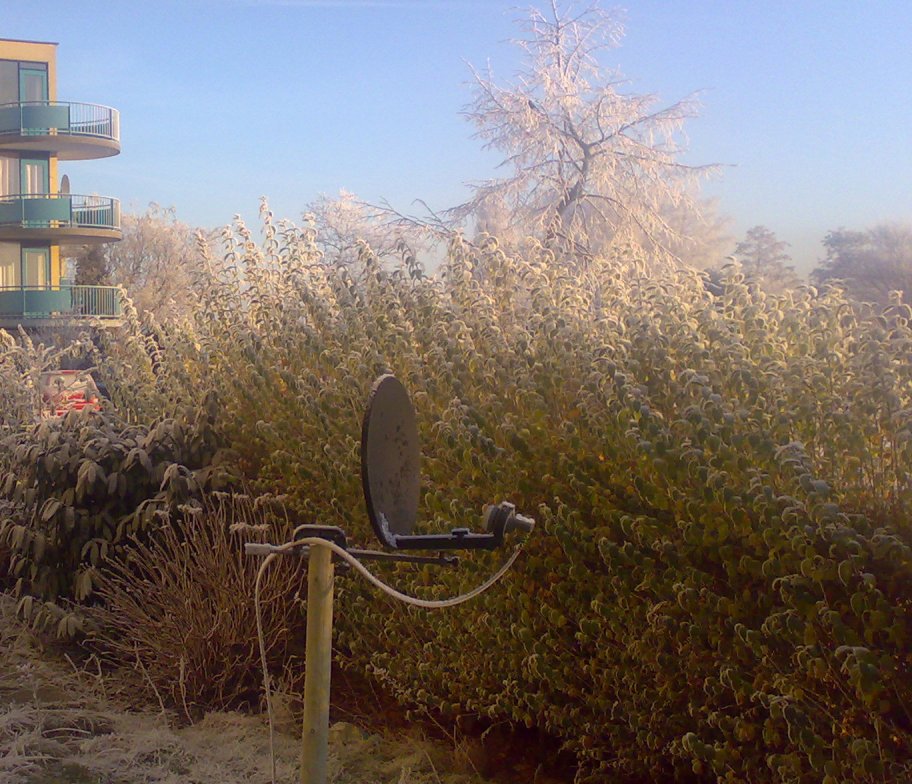
idem
I´ve in the meanwhile tried to look at BBC space relayed
broadcasts, which worked when it wasn´t windforce 10, at which
point I had to support the not so fragile beam with the antenna with a
broomstick.

The theater being wrapped up.
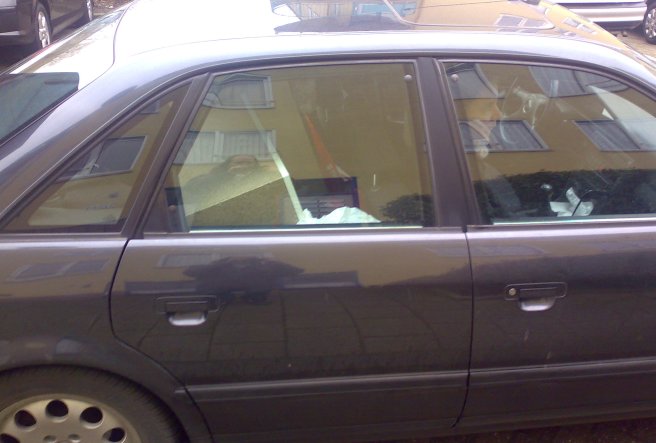
The sub and a main speaker on the backseat,
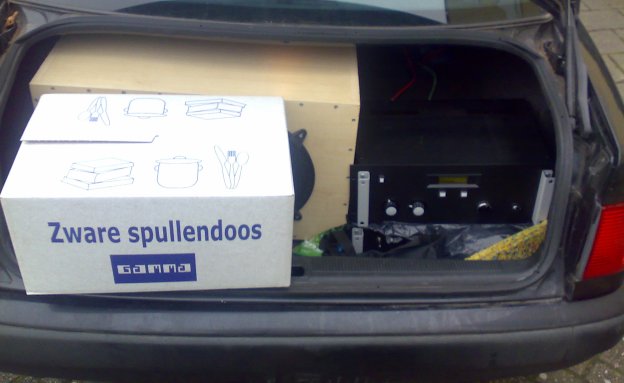
amps and the other main speaker in the trunk.
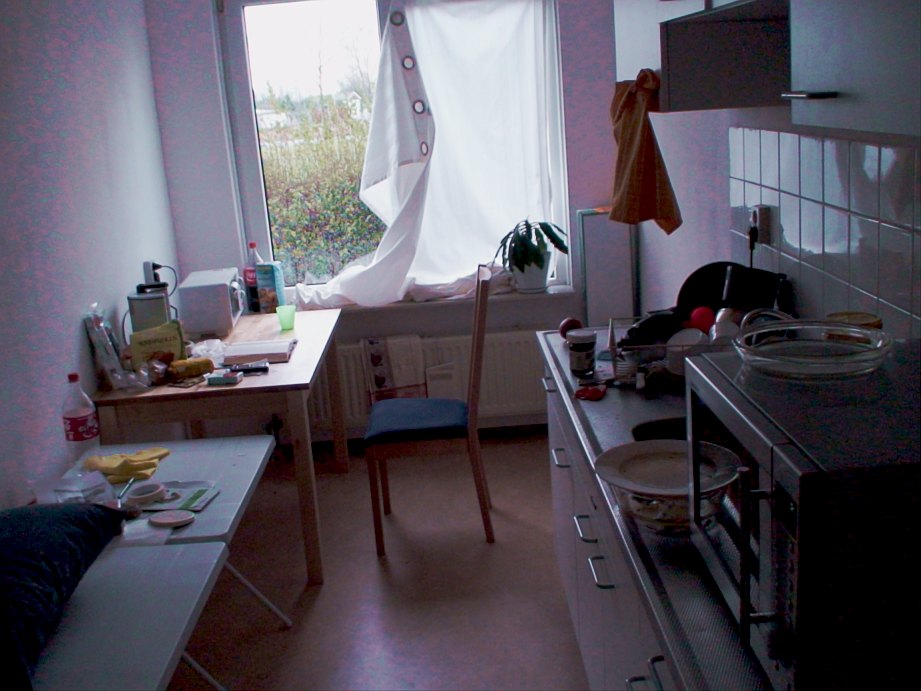
a temporary setup.
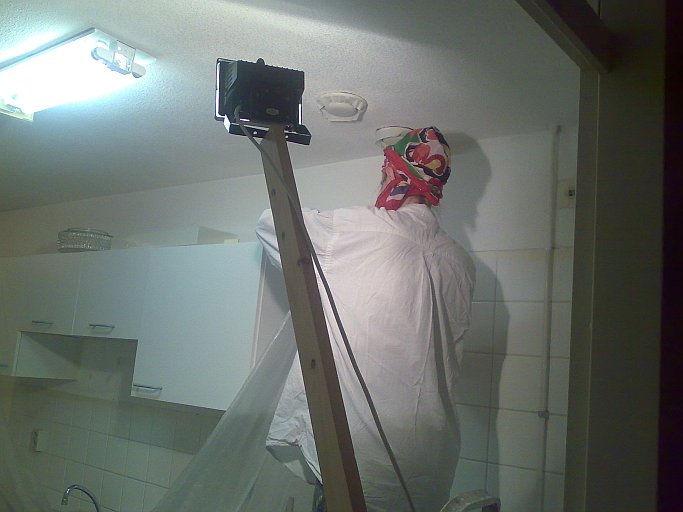
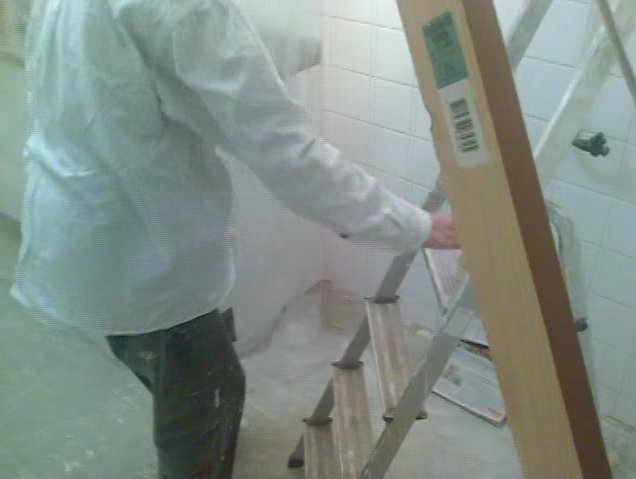
A video from Barbara doing kitchen painting,
click on the image.
(mpeg4, 640x480, 36 seconds, 5.1 MB)
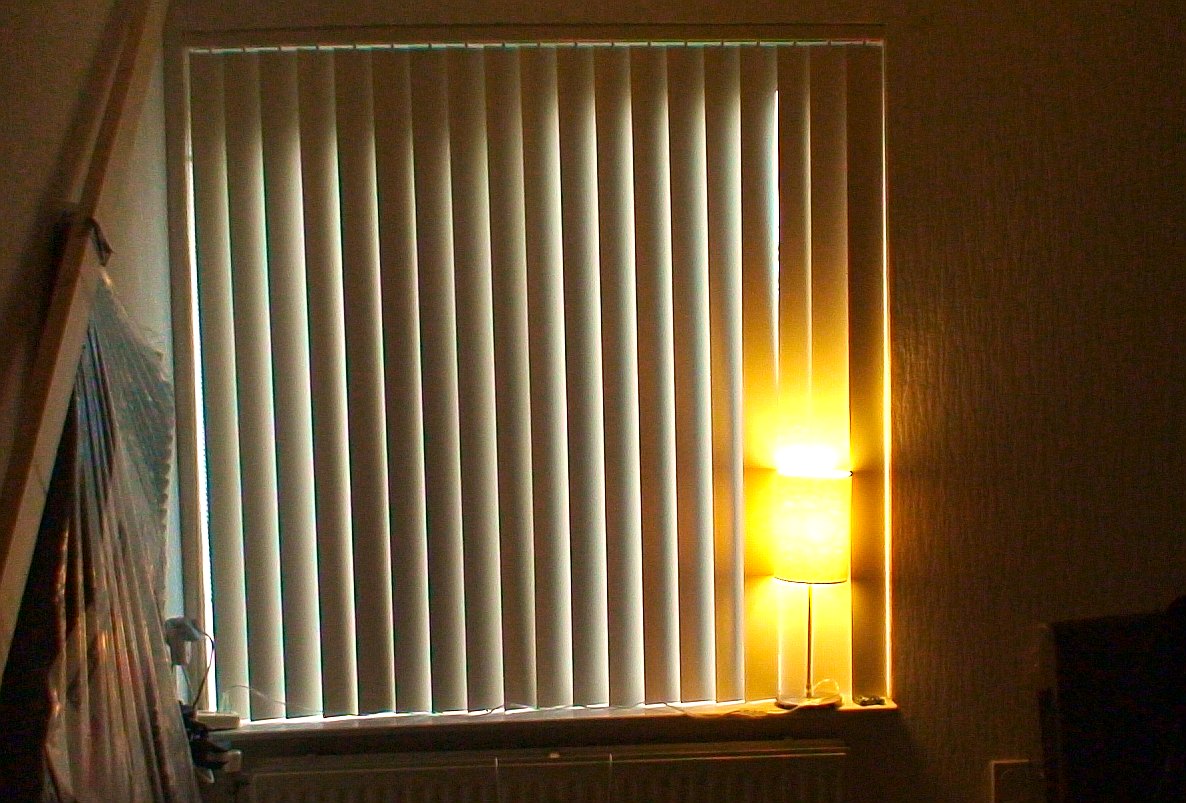
Pretty German-ish light.
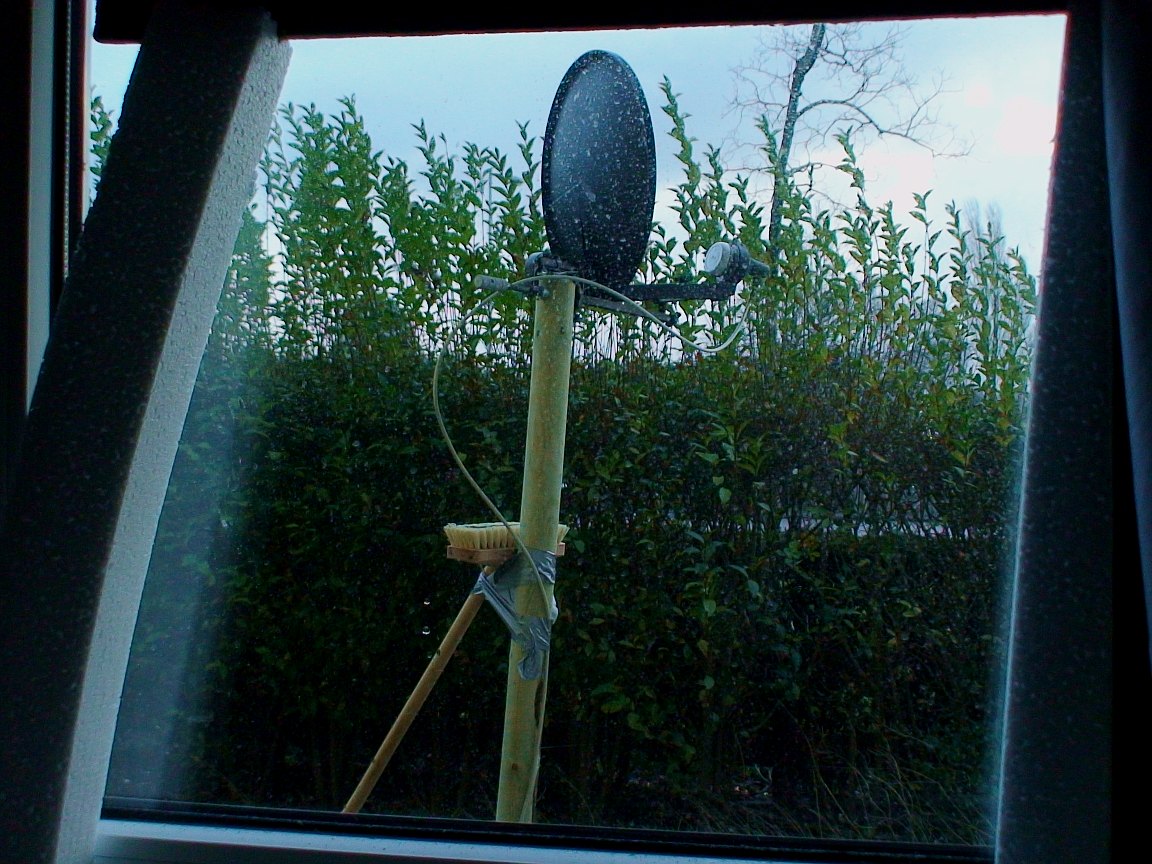
Hard winds require (improvised) stabilisation of the dish.

A start to make a frame to extend to almost ceiling-height which is to
carry a full layer of heavy sound isolation material.
Where this page was partially made:
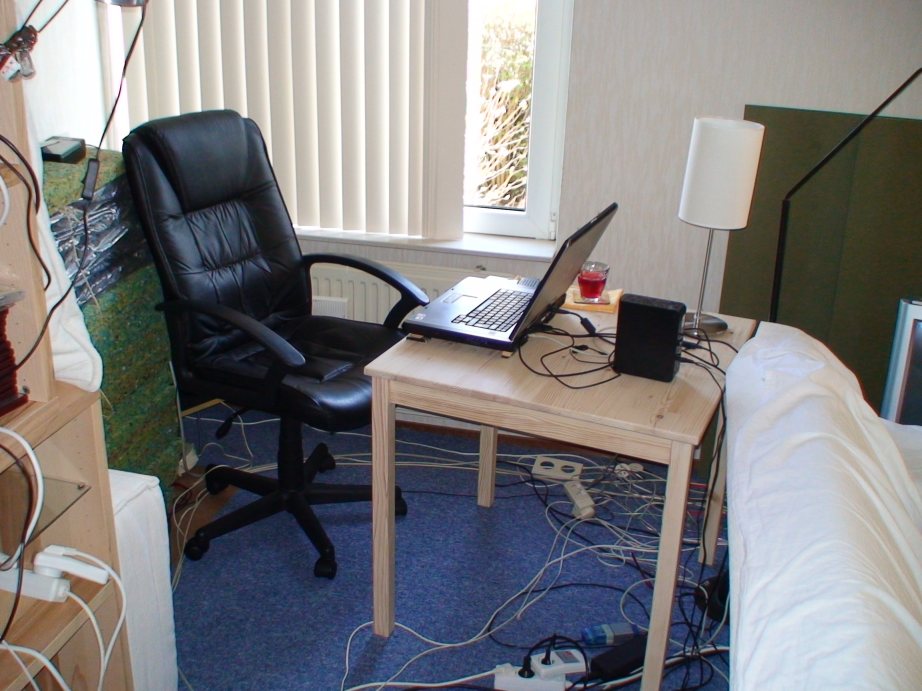
A little improvised workspace. The table is Ikea, and I for the first
time tried furniture oil on it, twice, to hopefully make it watertight
in 2 weeks. The tower on the left is an experimental beamer setup which
works good. The floor is isolated using soft and hardboard on hard
concrete, to create less resonances, the blinds I custom-made to
exactly fill the windowpane. The computer setup looks a bit modest, but
it has fully portable internet, it´s a Dell M90 (some years old)
with an actual 1080HD screen, which the quadro card can drive good, it
has a long USB cord to an excellent Lexicon Omega 24 bit AD/DA
converter, hooked up to my main amplification setup, and there is an
ethernet connection to a good internet pipe (over a megabyte (not bit)
per second download speed) and to a major server (where this page is
on) of which I remotely use X windows, too.
Oh, and the notebook has a recently installed Fedora 8 (32 bit) with a
perfectly working firewire High Definition camera link which even
allows live 1080 HD monitoring (using dvgrab -noavc -f
mpeg2 - | mplayer -cache 8196 - , giving stable and non-jerky
but not totally perfect HD viewing), a working Nvidia Quadro card
driver for fast graphics, also allowing the latest Blender combined
with the latest Gelato to work well, it has cinepaint, cinelerra (but
this version is slow), and the portable audio department is great
because I now can plug in the Lexicon and use Jack or even PulseAudio
(about which more later) with Rosegarden to do multitracking (works
great) and several synthesis programs, and I recently tried out
JackRack with some LADSPA effects on a live guitar setup which also
works with great sound.
And hopefully I now can mount.cifs a server partition transparently
again, which didn´t work on FC5.
The server (A 3.3 GHz Athlon 64 machine) where you read this from has
also been upgraded to Fedora 8, but is unfortunately has a problem
running dvgrab, which I want to use for a webcam. Also PulseAudio,
which I did the upgrade for mainly, has problems, altough it does work,
and I even got a remote audio stream to work, but it isn´t where
I want a multi machine 32 bit good quality Jack, unconverting,
distributed audio system to be, yet. I´d rather have no
resampling than not working user permissions and general messups...
This photo is HDR-processed from phone-camera 3 Megapixel original:
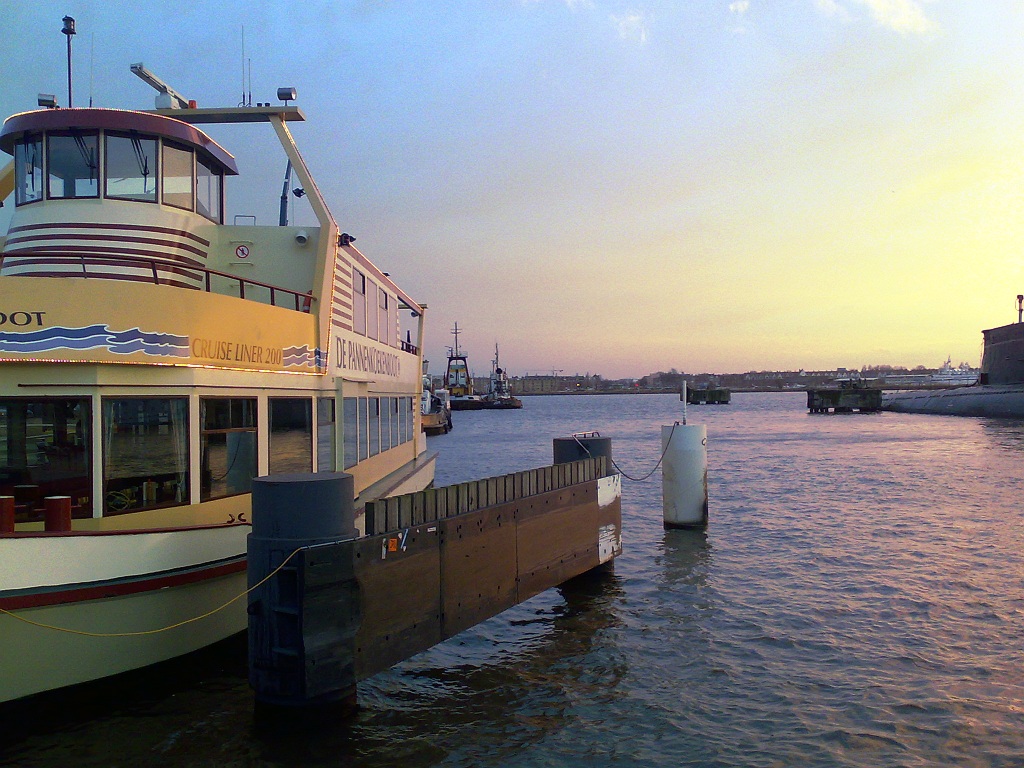
Mobile Web Serving
I was pleased to find it is possible to run a webserver on a mobile
phone:
theover.mymobilesite.net
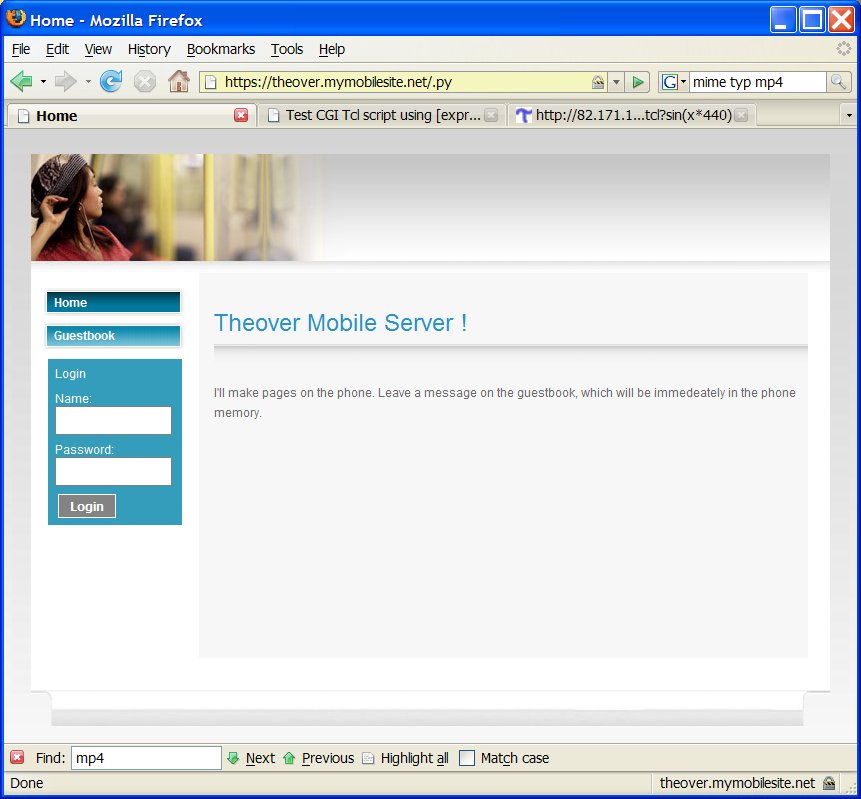
For a user with certain permission, it is possible to take a picture
with the camera when it's webserver is running, from a remote location,
that picture doesn't end up on the camera's memory it only appears on a
web page, but an audible photo sound is there when the photo is taken.
No GPS info, no flash though. Example:
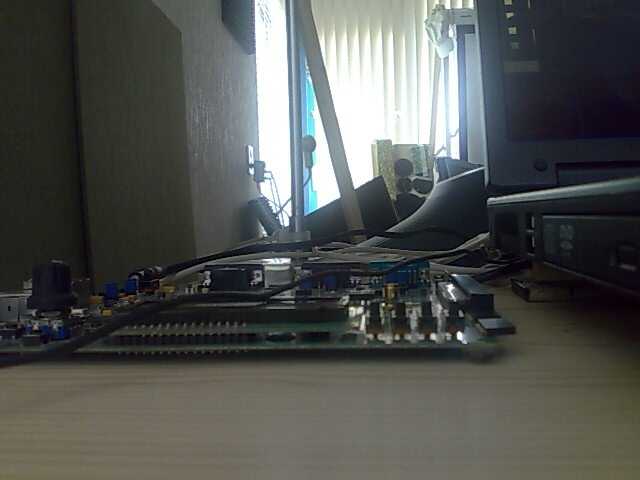
The server runs physically on the actual phone, it is an adapted apache
server with a lot of python scripts to present all kinds of menus. It
does take a little extra power!
I'm working on using not mobile serving but mobile viewing using a good
quality camera on the Fedora server side of which the live BirdCam is
visible on the mobile phone, after encoding for 10 seconds the mobile
phone shows a little downscaled 460x480 (DVD picture size) movie of 10
seconds of a birdhouse recorded in mp4, with audio!
The page I use for it now is this one I use
various coding sizez and qualities, and even at times TV is encoded, so
you might get 10 seconds of quite viewable CNN or so...
On yet another side of things, I made my analog audio mixer´s
Linux board finally connect to the actual internet over the
router/modem the such that it can download files from the internet (cnn
headlines on the machine display, or software updates, mix data, device
setting, ...) but also it can be reached from the internet, by using
http://82.171.148.176:8080
a page is routed to your browser which comes from the mixer´s
Linux control board, if it is switched on (mostly at the moment it is
switched off), mind that the IP address above may change, just use
www.theover.org to get the address, and then add the :8080 to try it
out, and in principle you might be able to control the volume of a
channel from where you are on the audio setup the mixer prototype
controls. Uuueh, this actually
works, I have used a mobile phone internet connection to change the
actual volume of a analog channel pair (feeding the audio amplifiers) !
Needless to say such control will not be generally on the
internet, because the system is VERY powerfull, and should not be put
loud by funny people on the web, of course...
Wed Feb 27 12:13:49 CET 2008
I´ve (obviously) switched this setup off until I make it a bit
more safe, that is, I took the internet connection down until I made a
few changes, so please check back later.
Some more Mathematics: the mathathematical sound wave server
Some pages ago I did Taylor expansions of a non-trivial integral which
is probably ´a bit much´ for any normal person out there
except edified enough engineers and some scientists or mathematicians
in a connected field. The added value of putting such for me
momentarily not so life or science essential but interesting
experimentation on my diary pages is that for advanced scientists it
does make clear maxima is doing good and that I did some relevant
mathematics when you consider that many things in science are based on
mathematics, especially when those things are well contained and offer
power otherwise not available, like practically speaking seemingly
unimportant limits to infinity, or Taylor expansions to mathematical or
scientific laypeople.
To be more interesting to non-experts, lets see what a powerfull
mathematics package like Maxima (or Mathematica of course, which costs
money) can do with more everyday formulas like the equation of
Pythagoras:
x^2 + y^2 = r^2
being the equality equation describing a circle in 2 dimensions.
...
On another side of things I made a test setup to render mathematically
generated sounds on the server!
I made a cgi script to run the mathematics package maxima, and some more
programs and tools automatically to generate a short audio file with a
given mathematical function as the wave rendered in it.
For instance I could take the maxima formula sin(440*x) which would
generate a perfect (in 16 bits CD quality) sine wave in the generated
sound file which can be downloaded and listened to, but if I feel a bit
experimental I could make very complicated formulas, like on this page or just play around with
fundamental waves like sine waves multiplied by an exponent:
sin(440*%pi*2*x)*exp(-10*x) (or: sin(440*float(%pi)*2*x)*exp(-10*x) to
make Fortran not have to crash because it doesn´t know symbolic
PI, this is the result).
All this can make wonderfull sounds, which the server automatically
puts in mp3 form, although it may be better to make the wav file
downloadable itself, too, because it seems various windows players
don´t like the 3 seconds long mp3.
The url is (carefull, I´m working on it)
www.theover.org/cgi-bin/math.tcl?sin(3.1415*x) where the part after the
question mark is the maxima formatted formula, with x being the
progressing time in seconds. The resulting mpeg is stored in http://www.theover.org/S/math.mp3
and can be freely downloaded and used. Currently you must make sure
yourself the formula is normalized, in other words is never greater
than +1 or smaller -1, and as I said x runs from about 0 to 3 and is
time is seconds.
The setup isn´t as easy as it might seem, and the maxima package
is capable of making and processing very complicated mathematics, so
the number of possible waves is sheer infinite. And the symbolic
manipulation is very powerfull such as to do formal differentation and
even integration, which works in practice, for instance changing the
above formula in diff(sin(x*440),x) gives 440*cos(440*x)
without effort for maxima.
Generating the waves is done by generating Fortran program code from
the maxima formula, after evaluating it, and then running a linked C
program with a loop over 44100 * 3 samples to create the .wav sound
file, so each time a new formula is entered, a compilation takes place
after maxima is run, and after that the resulting program is executed
to create the wav file, and after that a program to turn this into
mpeg, all automatically, and within seconds.
People may say: that´s a strange detour here, isn´t it?
Uuuhr, nope. The compilation of fortran and the C loop and small wav
library link take a little time, but this pays of big because the
evaluation of the formula for varying time steps becomes just about as
fast as a contemporary computer gets doing this job brute force
(without interpolating or repeated evaluation schemes) because the gcc
and gfortran compiler are excellent and give very fast executable
program code, the 44.1 thousand samples per second can be quickly
computed while one waits in this case for the page to download, and so
formulas can be rendered quickly. The maxima step is because of all
kinds of functions and processing steps and reorderings that can be
done with it, but rendering numerical results from maxima would
probably be prohibitively slow. The Fortran code generator comes
standard with maxima, just like the tex typeset output, so standard
maxima can be used, and thus far the sequence of program being called
works good, including for large formulas, like this one:
(sin(6.2831*110*x)*exp(-2*x)+(1/2)*sin(2*6.2831*110*x)*exp(-4*x)+(1/3)*sin(3*6.2831*110*x)*exp(
-6*x)+(1/4)*sin(4*6.2831*110*x)*exp(-8*x)+(1/5)*sin(5*6.2831*110*x)*exp(-10*x)+(1/6)*sin(6*6.2831*110*x)*exp(
-12*x)+(1/7)*sin(7*6.2831*110*x)*exp(-14*x)+(1/8)*sin(8*6.2831*110*x)*exp(-16*x)+(1/9)*sin(9*6.2831*110*x)*exp(
-18*x))/(1+(1/2)+(1/3)+(1/4)+(1/5)+(1/6)+(1/7)+(1/8)+(1/9));
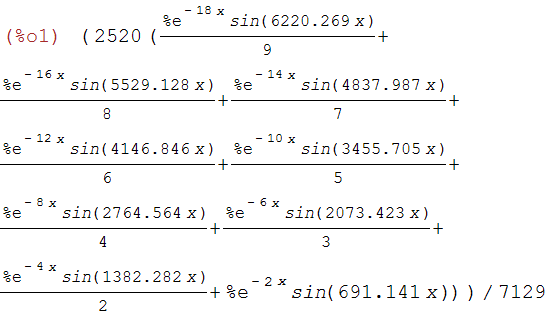
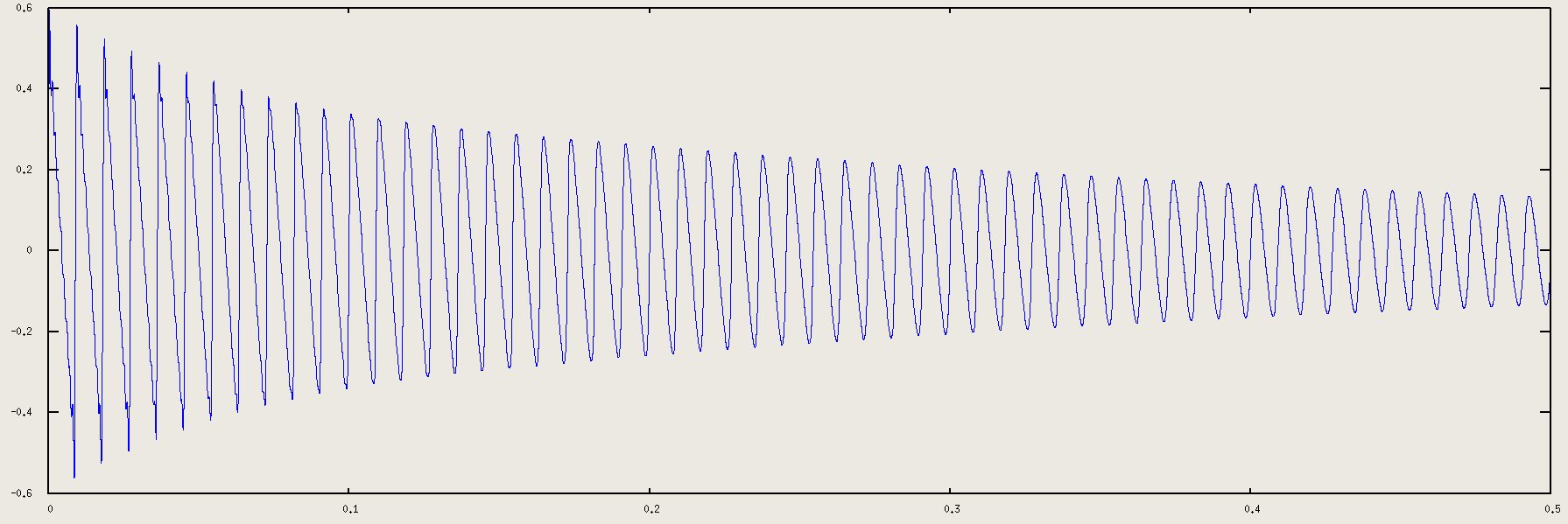
Of course the page is totally in buildup c.q. experimental, probably
the URL
translation isn´t even ok (yet).
Wed Feb 27 12:13:49 CET 2008
I´ve (obviously) switched this setup off until I make it a bit
more safe, at least some obvious ceavats should be gone like adverse
maxima commands as part of the formula. Please , check back later.
The Blues cannot be had
Because it is always going to hit back in the hand, twice as hard,
preferably. Mean statement? No the pope and the new age and such are
mean, like ´mother´ in a negative connotation. Some sins
and lifes cannot be forgiven, especially when they haven´t even
ended are are on purpose to hurt people. And some people only play at
the highest level and take everythings they can find, and require that
they are kicked out of their place, and probably will only listen to
either The Reaper, curses from God or hitting them twice as hard as
they do other people until the highest level is taken back for the free
and at times mildly good people.
A guitar-played blues, one take, no
elaborate production, 192 kilobit/sec mp3, 3.5 Megabyte, 2 min 24 sec.
Mike Stern will perform with the YellowJackets this years, isn´t
that great. And in fact a recording has been done, too. I should join,
too!
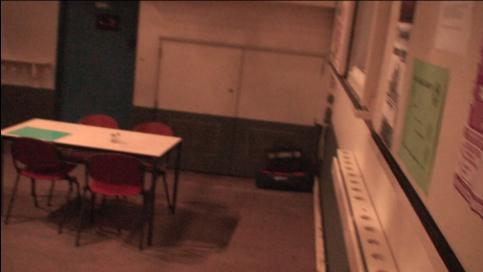
This is where I performed several times on keyboards/synthesizers in
the past, the Koornbeurs in Delft where, for other reasons at some
point I became member of this protestant non-corporal, non-initiation
rite club, and probably still would be if I´d have had money the
last times. Probably I played the blues there, too, but certainly
elsewhere in that town, too.
What about the title of this section? I think in general the blues
won't be had, meaning people won't be having control over it or debase
it in some general sense. And that it wins of the new age sh* called
music hands down just like other real music, and of the nig problems
having surrounded the good people.
Edited HD Film (Video)
The following are stills from the 3 scenes in a test HD film with
processing and editing, having used Cinelerra. I´ll put on a more
compressed version of the result, because my version is about 140
megabytes for 34 seconds, which is great on the 1080 screen and the 720
colour reference beamer (A 720 HD HD1000 from Mitsubishi), also
motionwise, and while not becoming as dead as a doormat anywhere in the
process.

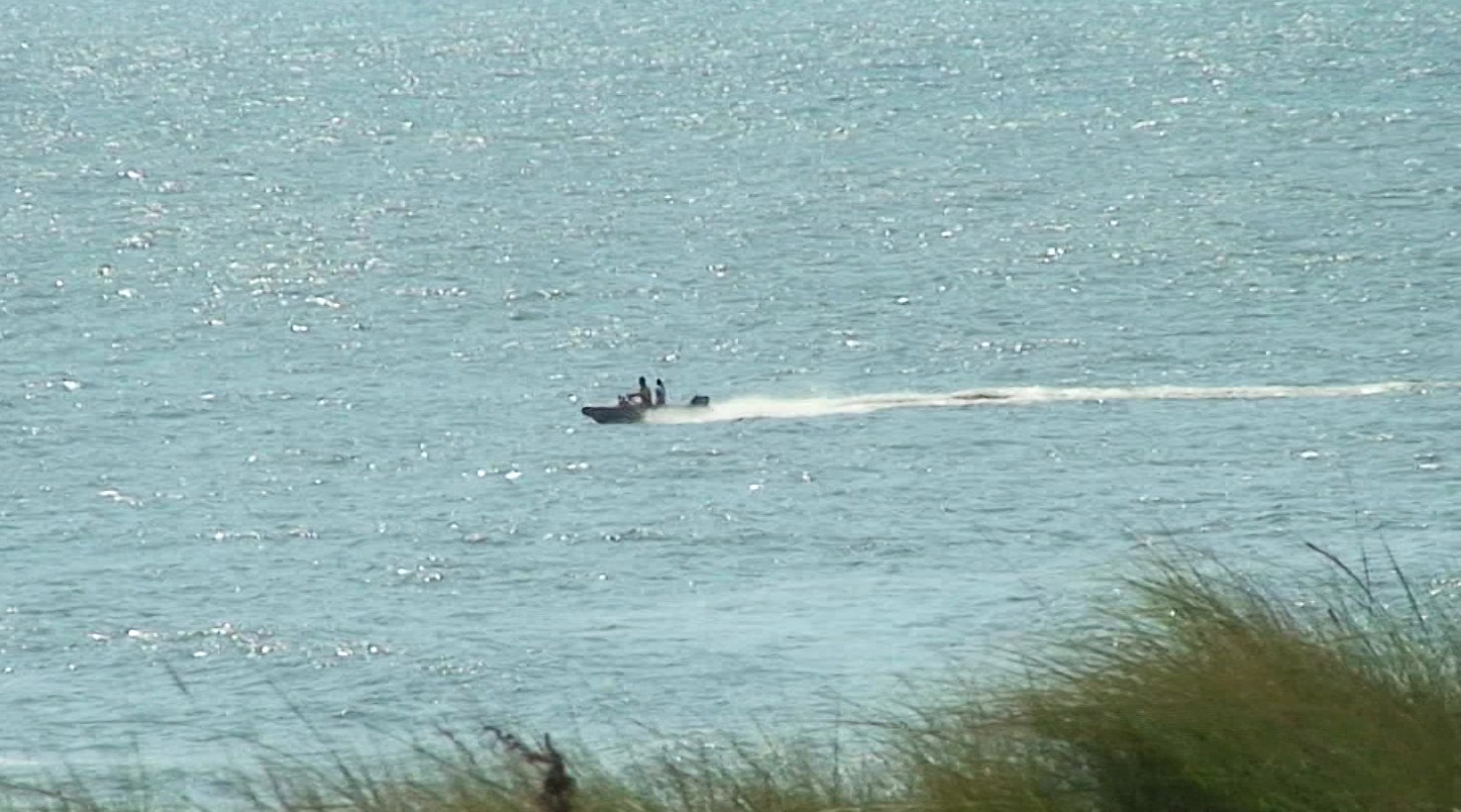
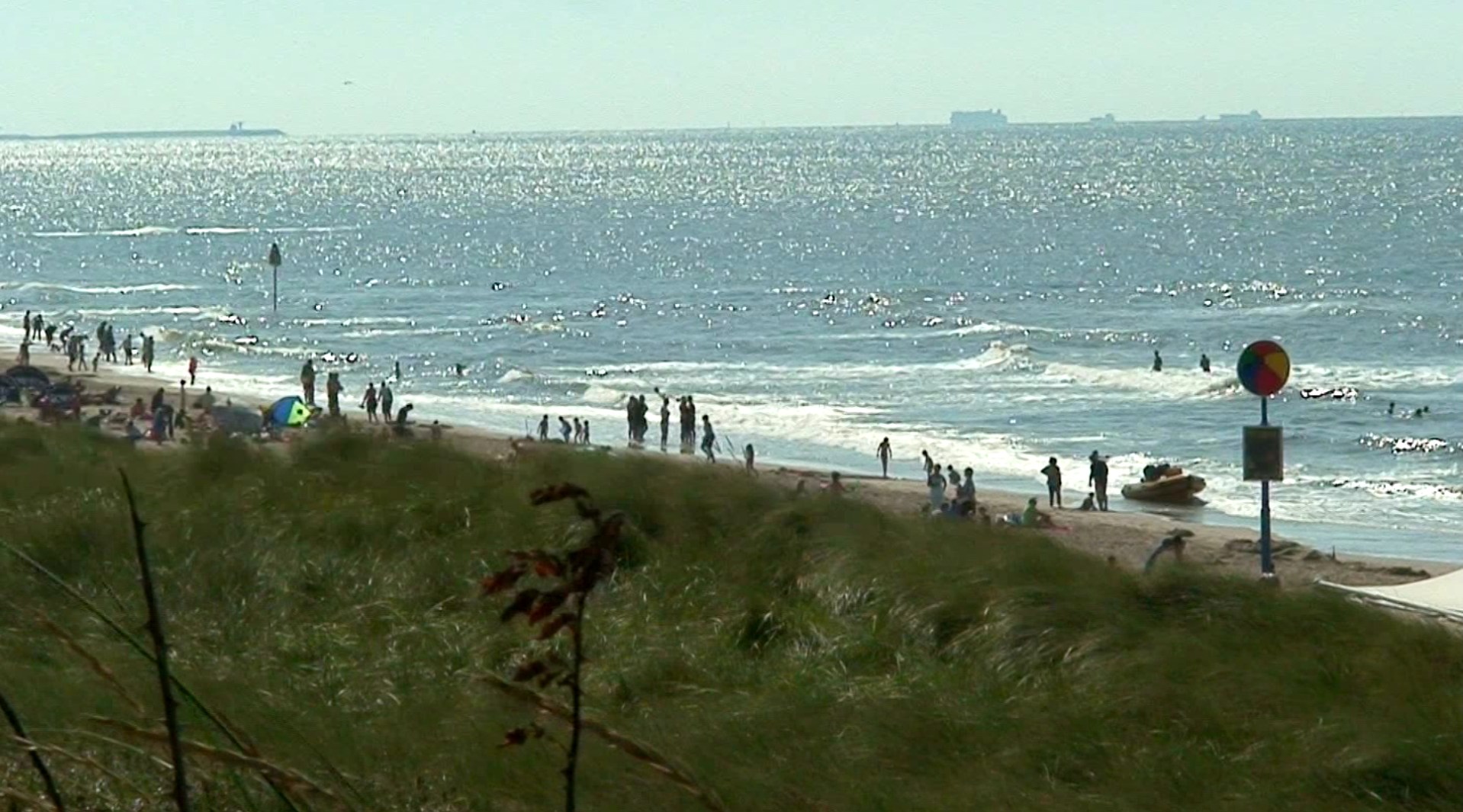
(couldn´t you pixel-*, uh -mess these to a bit smaller format,
Theo? Sure, but all that pixelmessing, heh...)
But this camera is not really HD, is it!? Eh, it is known to have a 2.2
Megapixel ClearVid advanced CMOS sensor with 14 bit signal processing
in it, so it should be normally 2k 16:9 capable, maybe there is this
issue which makes lets say 1 megapixel pixels into 3 x 333 kilopixels
RGB, I don´t know, except I happen to know the Clearvid uses 4
pixels (RGGB) per image pixel, but wether there are 2.2Mega RGBs or
2.2M any colour I don´t know.
The issue with stills is at least also that the motion and noise
present in the 25megabit per second MPEG2 transport stream (which
responds probably a more neutral than other compression formats) which
are deliberate, such as colour dithering and sub-pixel motion and
averaging of this, taking one frame doesn´t give a good
impression of the movie shown on a sufficient resolution and fast
enough LCD or (even better) on a DLP projector. I have made adaptively
frame averaged pictures using cinelerra, which do look better but I
cannot do partion motion estimation, which would be better still, but
only whole frame motion compensation.
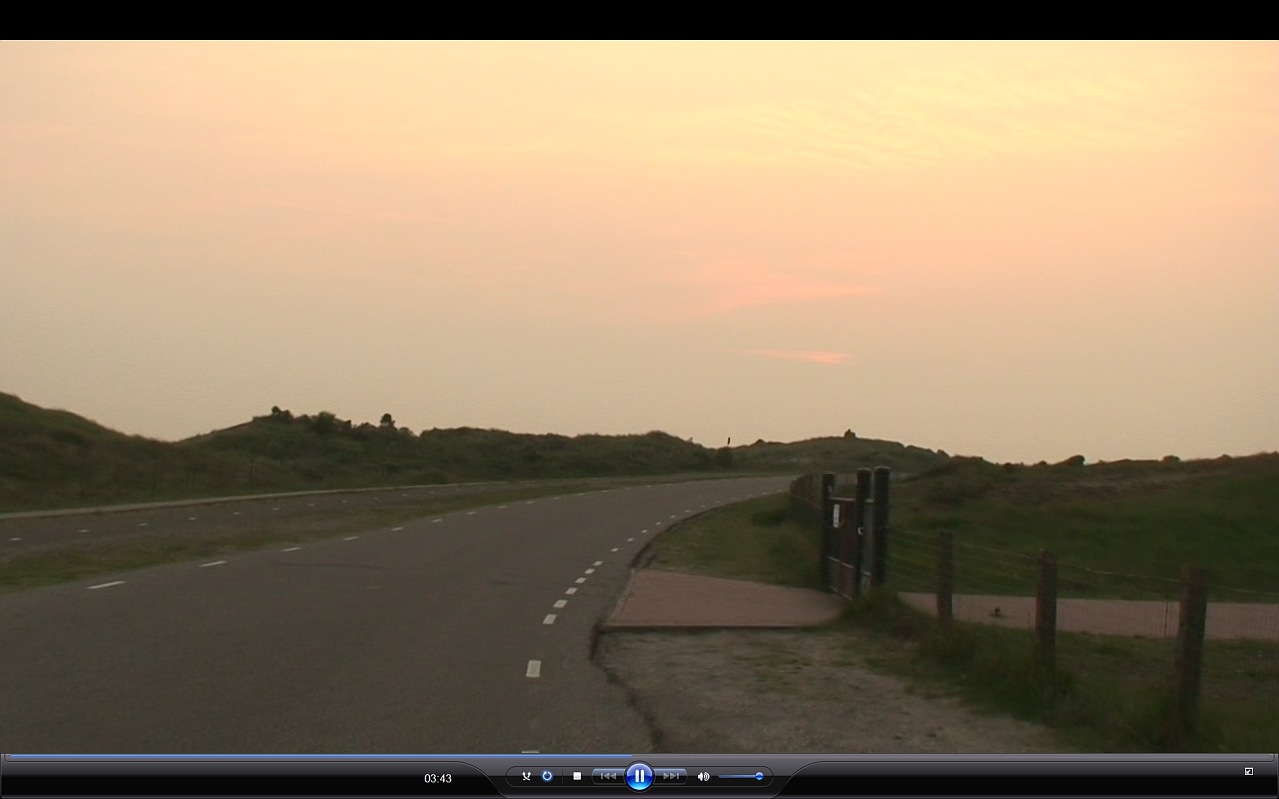

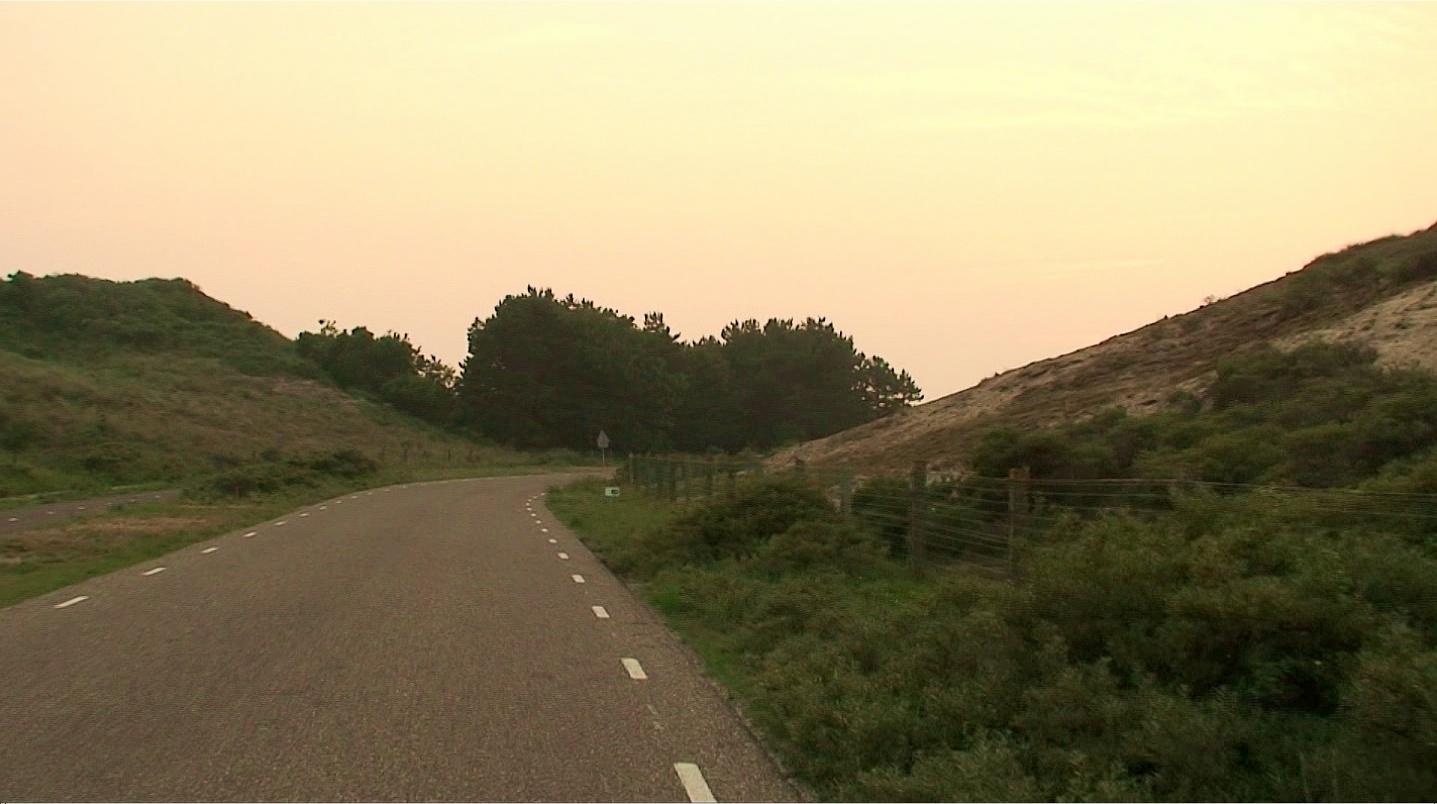
Visible by the PureVideo hardware accelerated windows media player
full-screen controls, the above is also an actual still from a playing
video, though shrunk afterward, from a HD recording from a moving
vehicle! So the above road at dawn is actually moving at up to
30/40km/h or so.
This of course is not easy to film with a modest high end consumer HD
camera or normal computer mpeg players, it requires using the right
settings and a lot of knowledge about the equipment, unless one is
lucky.


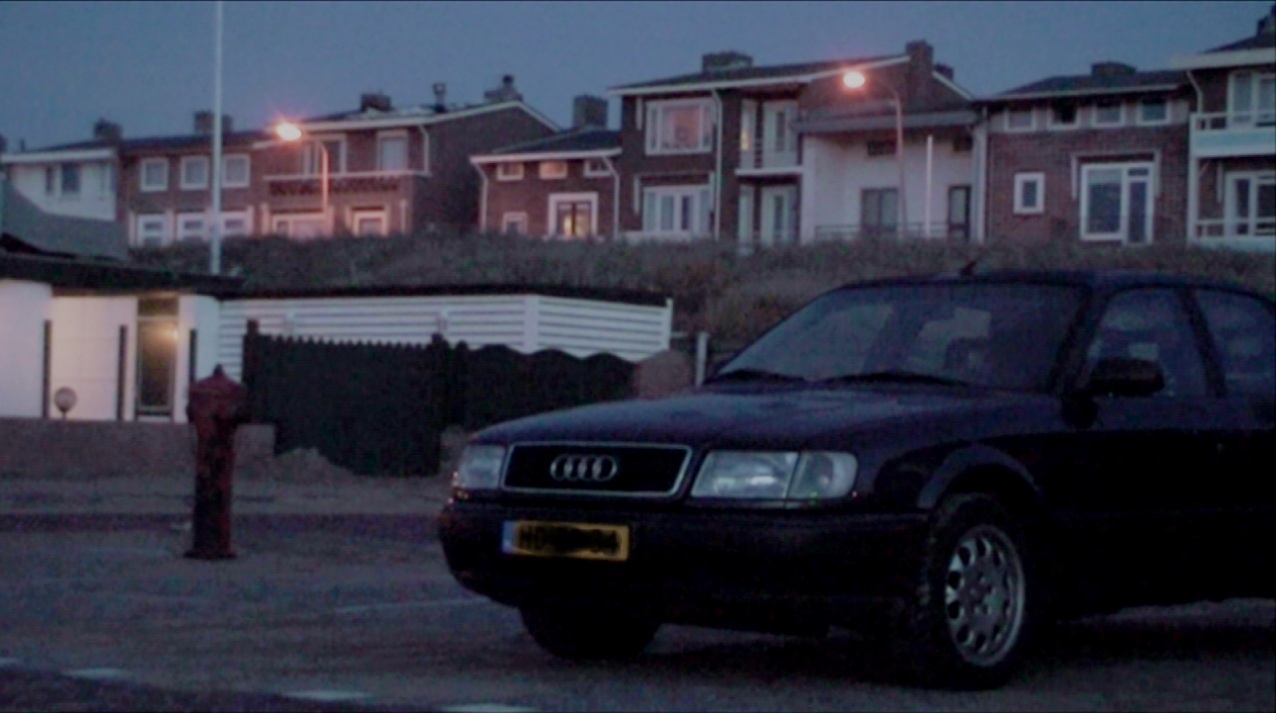
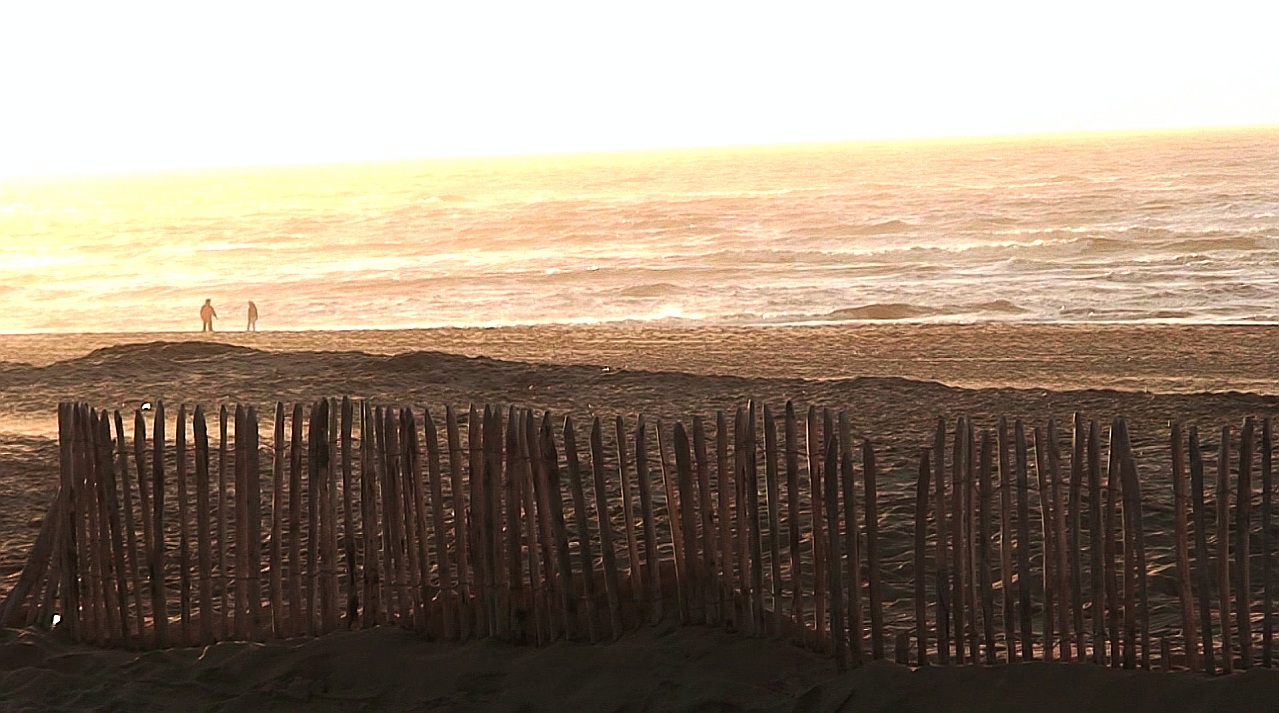
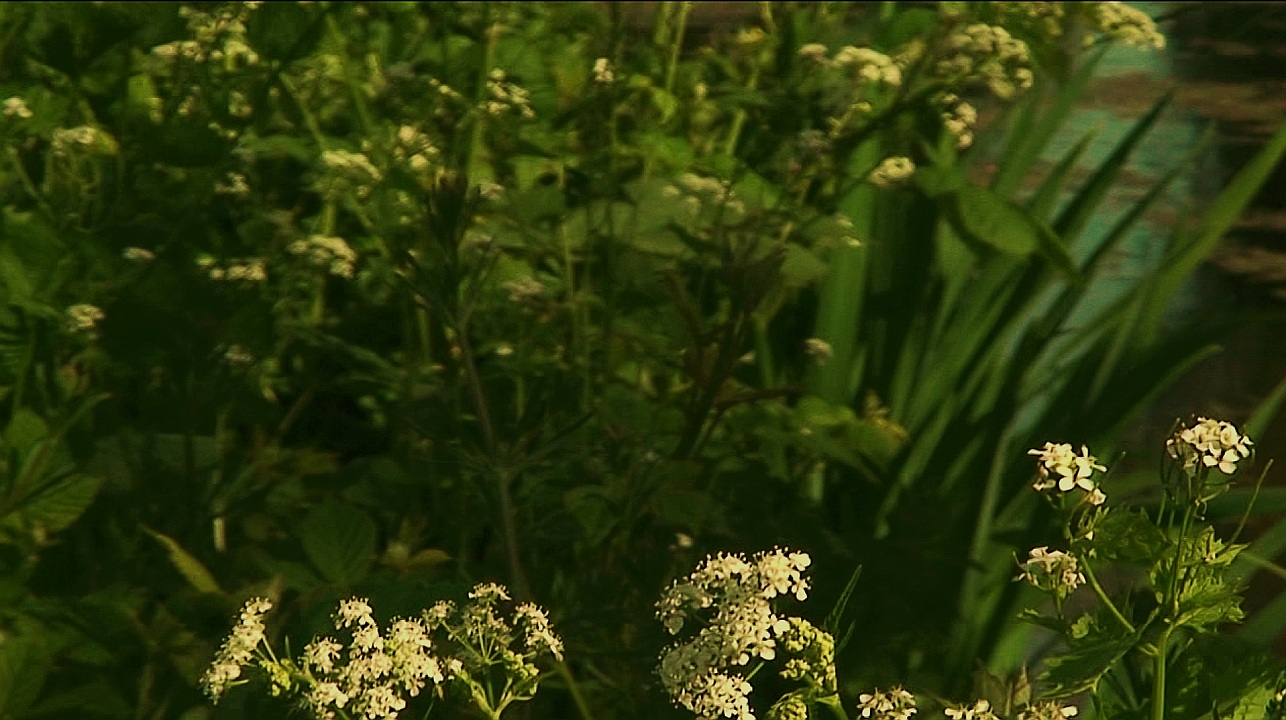
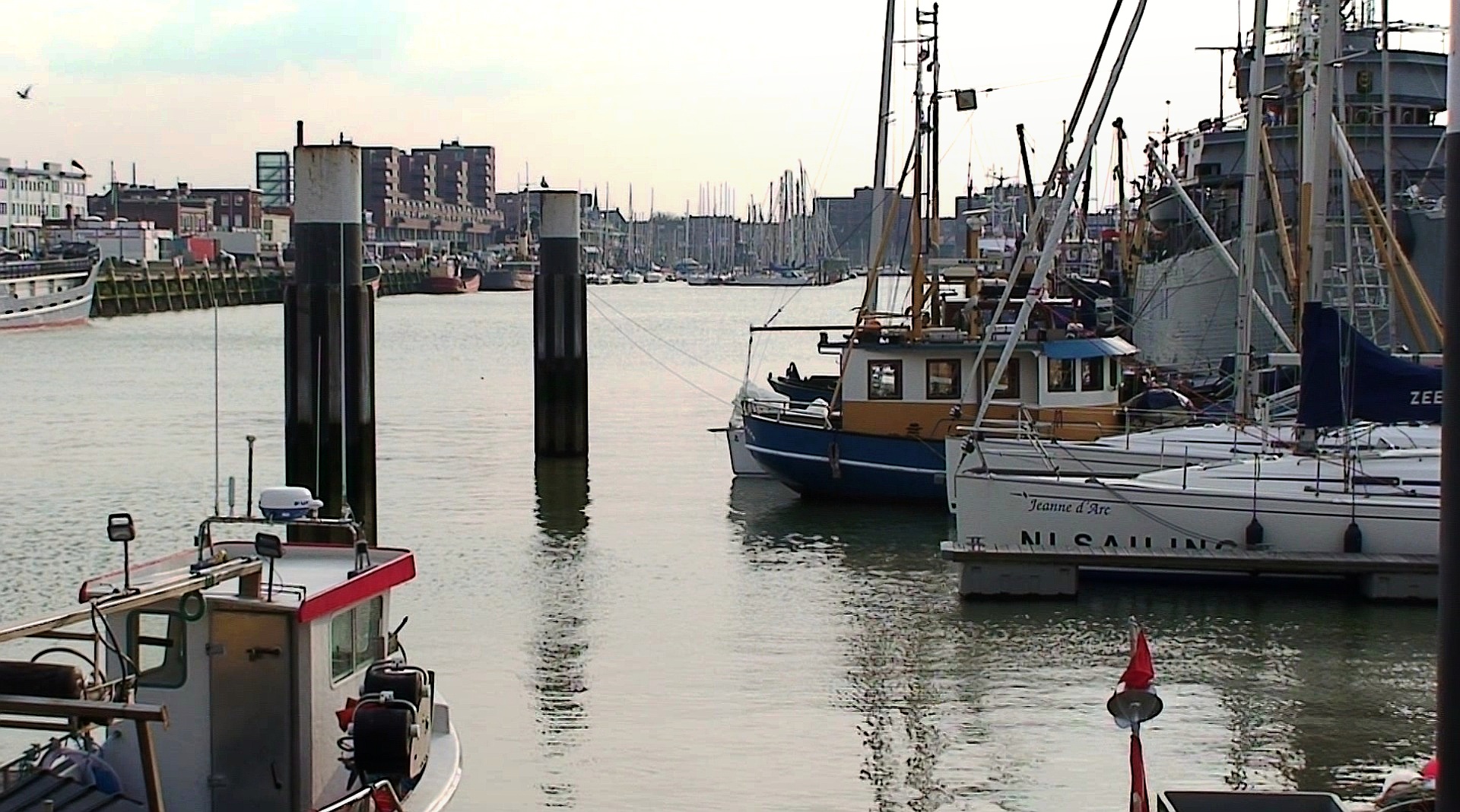
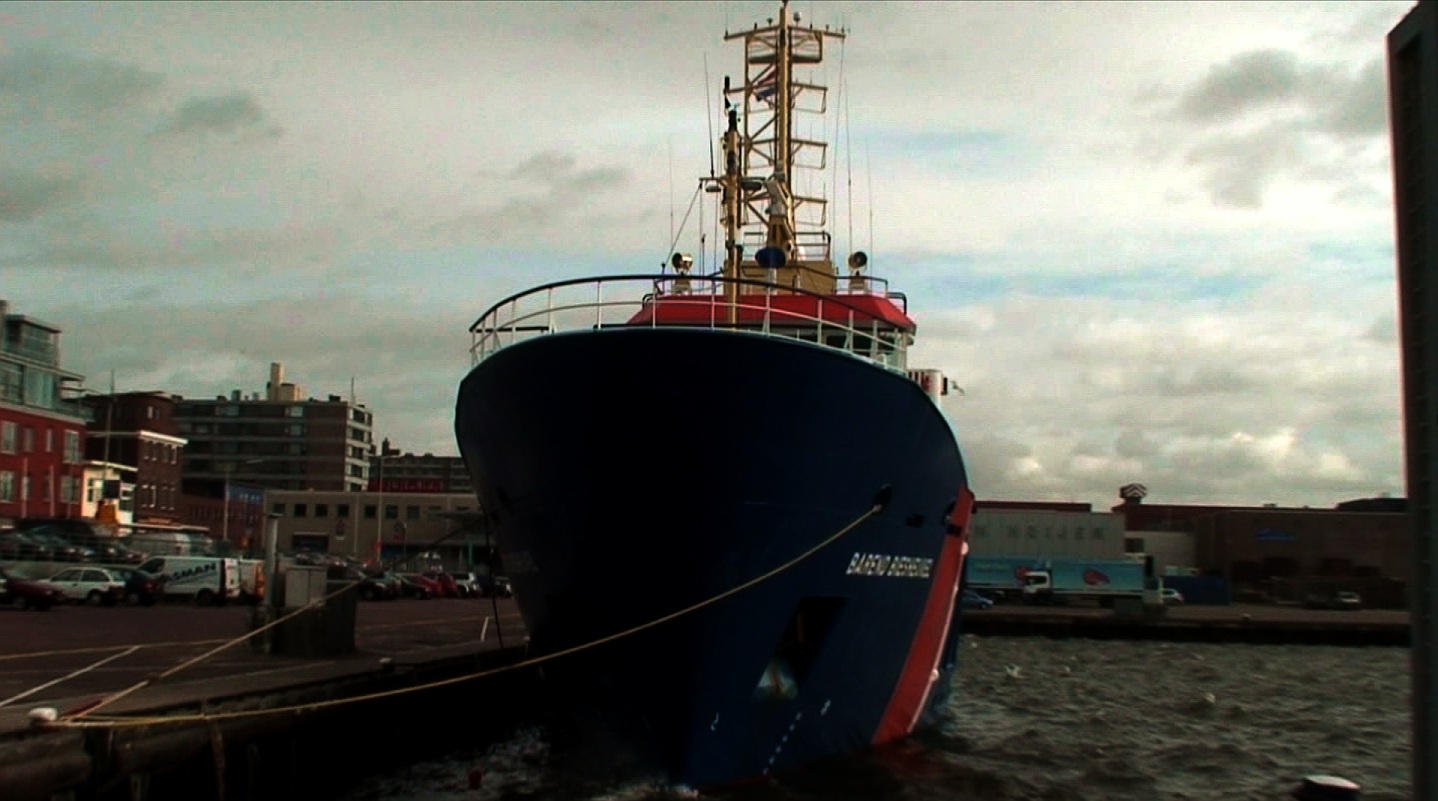
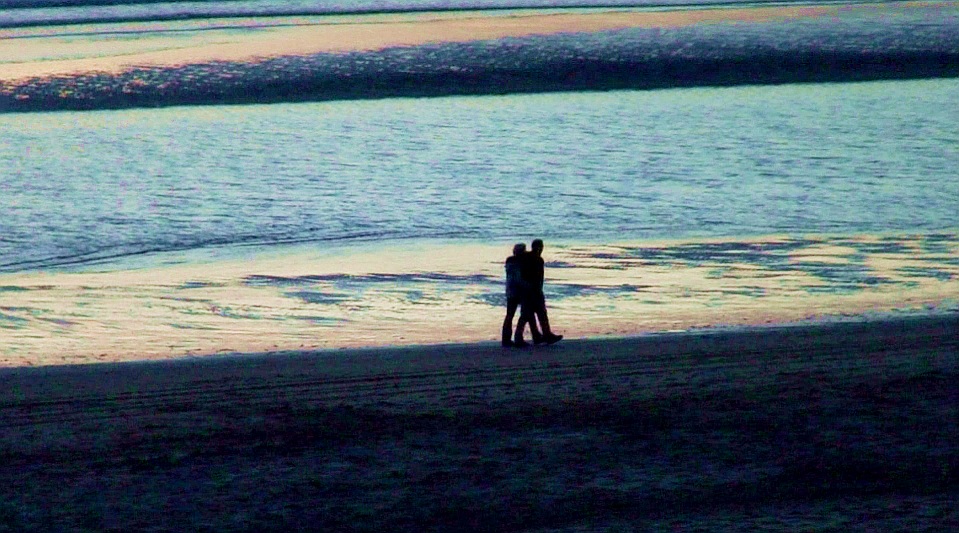
Remember, more than a few of the above images were taken with
non-stationary camera position and/or from moving scenes, of which the
following is a nice example, which is a large parking lot where I
filmed holding the camera in hand from a moving and turning car, with
no shutter applied, so all motion per frame comes through to the film.
Great impressions are possible that way, one frame doesn´t do
good justice to that:
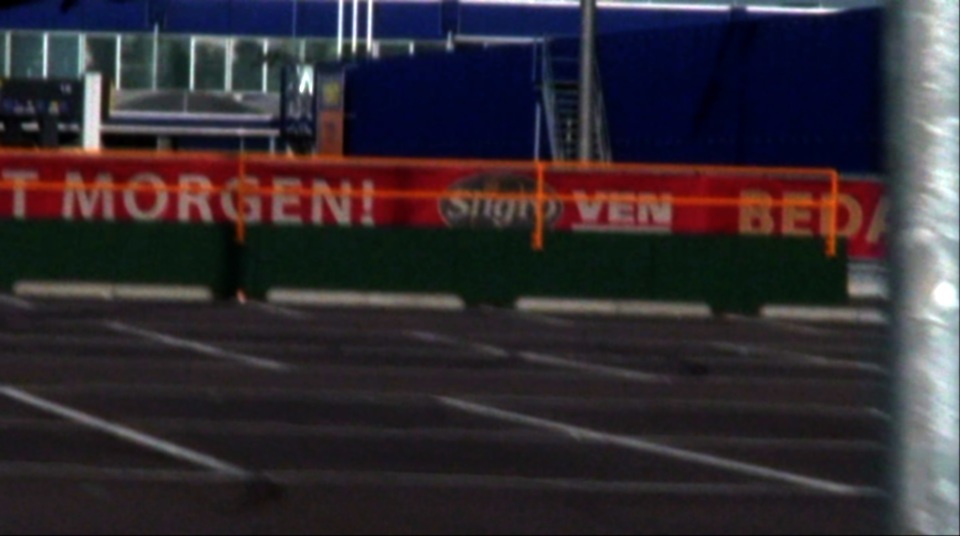
All of the above images were processed from the original HD video
material (and obviously most were scaled down), click on the images to
get the original HD frame (from before processing)!
Clearly, I´d like a 4k HDR cam and major (striped) disk space to
film with
for a change...
What is he saying here? Well, I notice all the differences in the
processed images, too, also on good CRT, various quality LCD and well
behaved DLP projection, probably the issues about pixelation and
distribution of illumination and colour sampling raised here are not
because I didn´t understand the latest standardisation process
about some video or photo format yet, but because I play with the whole
idea and liked "North and South" on a late 70s colour TV better then
the motion- and pixel-messed new shows over a digitally compressed
media box channel. Because that wasn´t so messing dead and
annoying.
The new age?
From pretty soon after I started I tried to record good quality HD
video, like I´m well trained in ordinary (576i) video which
worked good, but I also wanted to see how far it all would go rather
more than the shots in let´s say Dirty Harry or Jaws II or so
than most of the new cr*p or the obvious encoded video on the web or
the infamous media encoder box or so, no matter how usefull either can
be. So that the image is sharp enough is a given, although that is
quite hard in HD (like I presume in film, too) I take it for granted
that a serious recording is sharp, and that the sort of glossy-just-not
style is possible I believe, too, that is boring pretty soon, unless
maybe when it is truly glossy, which requires something glossy to film
of which there is little around in Holland, I must say.
Sound is very important in a good video or film, so I used this
setup for instance to test seperate sound recording from the excellent
cam microphones, for a lot better stereo, and still a lot vetter sound:
two AT2020´s with the Lexicon Omega´s excellent preamps and
24 bit AD converters are hard to beat:
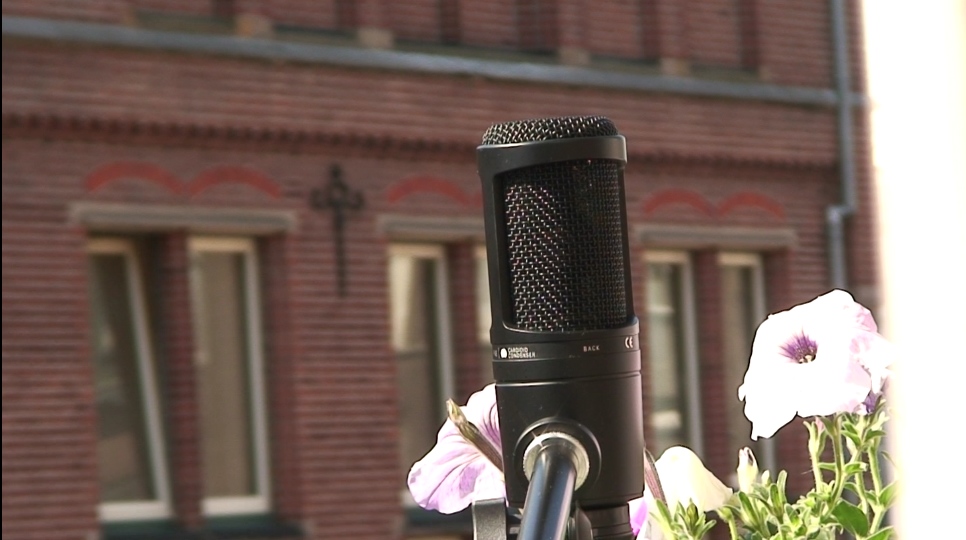
Of course recording the sound away from the camera postion is good too.
A random rest recording with steaminess, which even in 2k or about
2Megapixel film is hard to get easy:


No way that is HD video, Theo,
you´re conning us for sure. Maybe a bit advanced picture with
some of your effects or so. Eh, no. This is one of the first HD
recordings I made after basic practice with the cam, and it
hasn´t been processed at all, and in fact this is a frame from
the PureVideo enhanced windows media player (PureVideo harware HD
acceleration requires a player) straight screendumped from a partially
moving picture (the plants move in the wind). And this isn´t a
lucky frame or so (here´s
another maybe better to prove it) it is simply what the cam can do, and
the player too, although that requires more than a bit of work,
including installing the purevideo driver, which isn´t free (but
only $25 or so).
So the above moves !? Sure, and totally realistic, which looks great.
Dirac wavelet video coding
Well, it is an excuse to do block estimation and implicit feature
extraction and multilevel estimations too and therefore could be worth
to use instead of the ´motion field m*f*´ idea which I saw
on the last big IBC tradeshow being presented at Microsoft as the main
example processing software, being used for ´The Office´
(US version). That isn´t great. It s*s, although I´d be
glad to be able to do deinterlacing the way I´d like it and to
get some good local motion estimates for colour enhancements and other
improvements on my HD video.
That "dirac" doesn´t work Theo, it´s just brittish
propaganda, it is only sounding nice, they got some stuff from some
nice californian inhabitants, and that should do something, but they
don´t have a clue either! It doesn´t compile, and otherwise
there are fundamental impossibilities to use it!
Arg. Well, I guess I didn´t give Unix (professional predecessor
of Linux, which copied just about anything from it, which mostly was
legally no problem) courses back in the late 80´s for nothing,
and didn´t program at university for no reason.
It can be used, but honestly
it does force the use of uncompressed files in various forms and is
probably therefore educationally decent, and as a consequence eats disk
space even for a few seconds of 1080HD film being fed through it frame
by frame. I took a little piece of HD film I made which I transformed
from mpeg-2TS (25Mb/s) to uncompressed 8 bit RGB TIFF frames using
Cinelerra.
Those I streamed into a converter program from Imagamagic, which can be
yum-ed from Fedora (8/64) to make a big red green blue with a byte per
colour:
convert t/ti00*.tif -adjoin ti.rgb
I presumed the shell or library wildcard expansion would do a
numerically ascending list job, which appeared to be the case. Then I
used the Dirac converter to 444YUV form, stating the picture size (I
didn´t expand the size to 1920 wide, whcih I did afterward again,
though probably the pixel interpretation through the encoder
isn´t perfect this way) and number of frames (or fields):
dirac_RGBtoYUV444 < ti.rgb > ti.yuv 1440 1080 64
Now the direc encoder, presented with a ´- local´ option,
is started to generate output frames fromthe encoding process, which
goes at about a frame per 3 seconds on the fast notebook I used (though
it used only one core of the 2), and I think I might have added
´-interlaced´ which would correspond with the source
(´I´) format but the encoder cannot be given options it
lists itself when called with --help to tell it to use bottom frame
first and encode either with or without interlaced result:
dirac_encoder -HD1080I50 -cformat YUV444P -verbose -width 1440 -qf 9
-local ti.yuv tt
The verbose option shows a lot of information about the coding process,
and of course there are many more options for which I used the
defaults. The result needs to be converted back to a format I can read;
dirac_YUV444toRGB < tt.localdec.yuv > ./tt.localdec.rgb 1440 1080
64
Now the imagemagic viewer can be used on a machine with sufficient
memory:
display -size 1440x1080 -depth 8 tt.localdec.rgb
Frame for frame the output can be viewed that way. I used another
imagemagic command line tool to get seperate frames back from the
encoder results, in this case as a set of very high quality jpeg images:
convert -size 1440x1080 -depth 8 -quality 98 tt.localdec.rgb
t/ttlocdec.jpg
Which I put back into a mpeg2 transport stream using ffmpeg to use my
Purevideo player to show the result as a short movie:
ffmpeg -i t/ttlocdec-%d.jpg -f mpegts -b 40000k -r 25 -aspect 16:9
ttlocdec.mpg
The following picture is a screen dump from this last step:
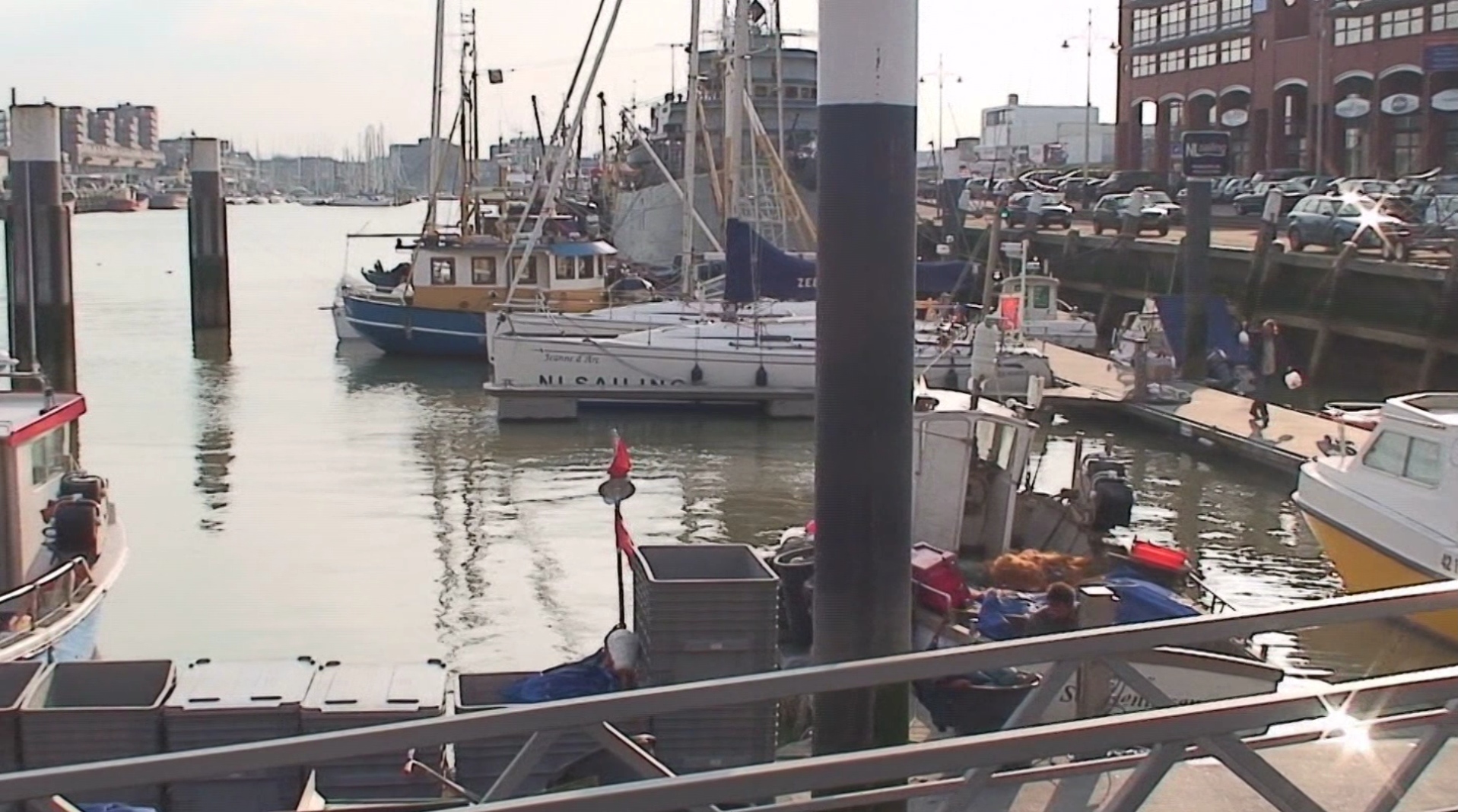
All these pictures are big, but otherwise the results look a bit
deteriorated. Oh, yeah, I know about the magicall ping format:
doesn´t make it much better for serious videos or pictures,
possibly for screendumps, and at least these big images are compatible
with most browsers on earth.
To make the above a bit more interesting, the frame is from a moving
scene: the camera was making a fairly slow pan during the above
fragment. It is clear the encoder at quality equals 9 isn´t
perfect. The original with Purevideo is fairly straight ok, but the
general impression after the wavelet coding is quite different and more
realistic, and probably even though there are blurred edges, the
realism increase through motion estimation and the broad, unedged
average filtering of the wavelet is a fresh and welcome effect after so
many ´sharpness effects´ and pixel pattern messes.
I´ve experimented years ago with the then new jpeg2000, probably
because I had example code for a DSP (which I never used) and the
multilevel analysis of this is probably interesting for the new digital
cinema which cannot afford to run from a multiple striped disk doing
big full frames at 4k/25fps times 32 bits times the number of colour
channels, if not it is usefull to analyse frames with, and keep away
from dct block tricks making every light effect larger than 16 pixels
broken from the start. So are the not so incredible effects of the
transcoding visible you might ask, yes they are. I view on a 1080 HD
monitor screen on which the perception of the image at distance varying
from close to about a meter of the 17 inch screen are profound enough
to spell out the differences between lets say a good projector
impression of good material, a good book picture (a well made one), and
a badly procecced video, myriads of pixelmessed web pictures and
"The Getaway" from HDdvd (including supplied x2xn magnification),
compressed video and a burst of HDR raw camera images.
System struggles and solutions
Well, I installed Fedora 8/64 on two machines, amoung which the server
on which these pages are served to you, and I installed Fedora 8 (32
bits dual core) on the Dell M90 I use to make this page at the
moment, which is a great improvement because on the notebook I can now
use the Lexicon Omega 24 bit AD/DA Usb converter on Linux with
Rosegarden which gives a very good audio signal path, and of course
with synthesizer programs and effects (LADSPA effects with the stereo
Jack-based signal path of jack-rack and also the notebook now has a
midi interface through it.
Also, the advantage of F8 is the use of dvgrab -f mpeg2 which means I
can read (also portable) HD video from the camera without glitches or
startup time issues (as it was). And the mount.cifs local network
mounts to server window shares works easy and transparent, so big video
files (I mean several gigabytes easily) can be used y just clicking
onthem and putting the time slider anywhere and the files will be
served and the video player respons instantly without problems, which
for HD with the Purevideo hardware rendered isn´t bad. Even the
extra 320 GB external disk is put on the server and can be accessed
over the (imitated, it is Redhat Fedora 8) local network.
There is a struggle here though: dvgrab works on a 64 and a 32 dual
core system, but not on the server. I even compiled it myself ( I add
string.h defines everywhere, skipped some test if with casting
definitions and later skipped another test which erred) but it
consistently doesn´t work on the server machine, maybe the old
german firewire card doesn´t work with the new protocol stacks, I
don´t know.
Which brings me to the next subject, I started to work on a webcam
which is called "The BirdCam" because it is making a picture of a
birdhouse! It can be easily understood I wanted the firewire to the old
video camera to get images, and I even plan to stream video, or make it
downloadable as mpeg4 from the server, and preferably usable on a
mobile phone like the Nokia E90 (the Communicator with big screen)
which should be able to use mobile internet to get a DVD sized movie
from the server. In fact I tested this is possible with the real good
quality but years old consumer Sony digital video cam with major
´analog´ zoom lens which instead of over (digital)
firewire cable (al long one, and it does support ieee1394) is coupled
to the server with a S-video cable (and sound connection) via a
Pinnacle PCTV Deluxe digitizer USB box, which is yeeeaars old, and has
broken already two supplys and which encodes into mpeg2 (or 1) in
hardware for about 6 watts of extra power. Also, it can be adjusted to
receive cable TV channels at very good quality for consumer norms at 6
megabit per seconds. The box has a good new major wall wart supply form
Conrad now, which is rated to the required power and not so big, which
doesn´t get hot (the previous one was not normally loaded too
much when measured, but it had a little less power then the rated box
consumption, probably peak, so it blew up when I switched it on the
last time...) Since Fedora 6 I could use the usb box together with the
Dune tools, which I compiled and then reasonably reliably connect over
the use connection. Hours of TV watching over the local network are
norm, not exception.

Original size from
hardware mpeg2 encoder played with mplayer
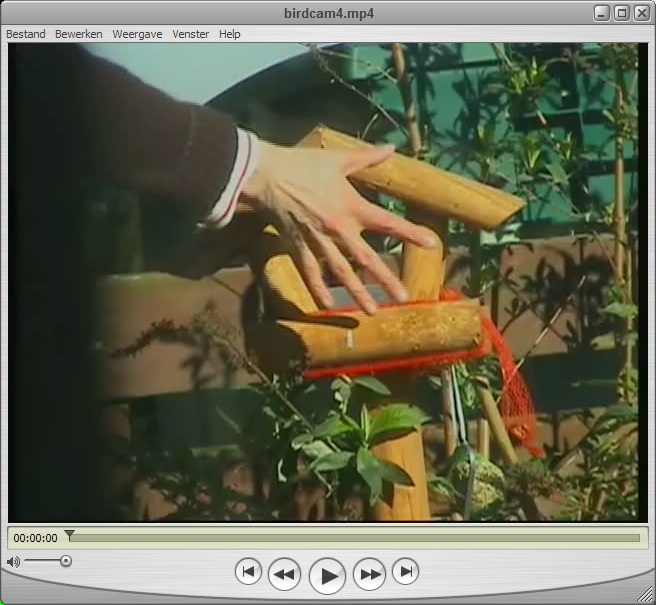
Example test movie
after mpeg-4 encoding played with Quicktime.
You can download the above test movie yourselve from here ( ) and
I tested it on a Communicator, which indeed plays it wonderfully! It
does probably require a mimetype upgrade on the server, because it
downloads a bit cumbersome.
Recently I've added th mp4 mimetype for apache and now the mobile
downloads neatly, no problem. Currently the can is live (but mayeb I'll
change things again), and the last 10 seconds movie that has been made
should be downloadable from here.
Based on the Dirac transcoded HD I tried out processing a resulting
frame with the 8 bit Gimp, getting some of the combination of
sharpening filtering and intensity variation things to work like
likable pictures, even from long ago:

Or a (not just desaturated) black and white TV or movie effect:

the effectiveness of the effects also depends on the monitor, and of
course I don´t have 4k materials to reduce to 2k and then
pixelize in ´certain ways´. Wink wink.
So this calls for cinepaint at least, an I would prefer a Dirac (or
schroedinger implementation which is the same codec spec) which would
use more input and output bits, of course at the expense of bandwidth
of the coded signal. I have cinepaint, and also cinelerra can work in
32 bit floating point numbers per
colour! That´s great, but cinepaint doesn´t do
everything gimp does, like the sharpening filter isn´t adjustable
to be more subtle. I know there are also scientific reasons for many
things, and that I shouldn´t aks people to send me a free
photoshop with my wishes implemented, but then again, I am sure certain
things are worth looking after. Like how oneis going to use images; on
a small screen, a computer screen (of which resolution woud better
increase with time) a TV (higher brightness possibly, and attention for
motion) or a cinema grade system, high Q monitor or small or big beamer.
The current solution to have my interest: 4k 16bpc 24 or more f/s
recording and at least even bigger (more than 106 inch diagonal)
projection with lets say 4000 lumens and great and type-adjustable
pixel colors and of course 4k resolution. And I keep waiting for a
great job to pay 20k and the rent and ticket or so, too...
Well, and then the Lexicon USB AD/DA converter fell of a small table
and again didn´t work good, which happed since I tried to pull
the knobs of the fron real hard. I resoldered the potmeters and it
worked again, but this time I start to suspect a break in the printed
circuit board, though I did get it to work again. The F8 on the
notebook with mplayer and the new dvgrab allowed me to do real time HD
viewing from the cam, which I used to inspect the lexicon pcb´s,
at least to look up chip numbers, of which this is a screen dump:
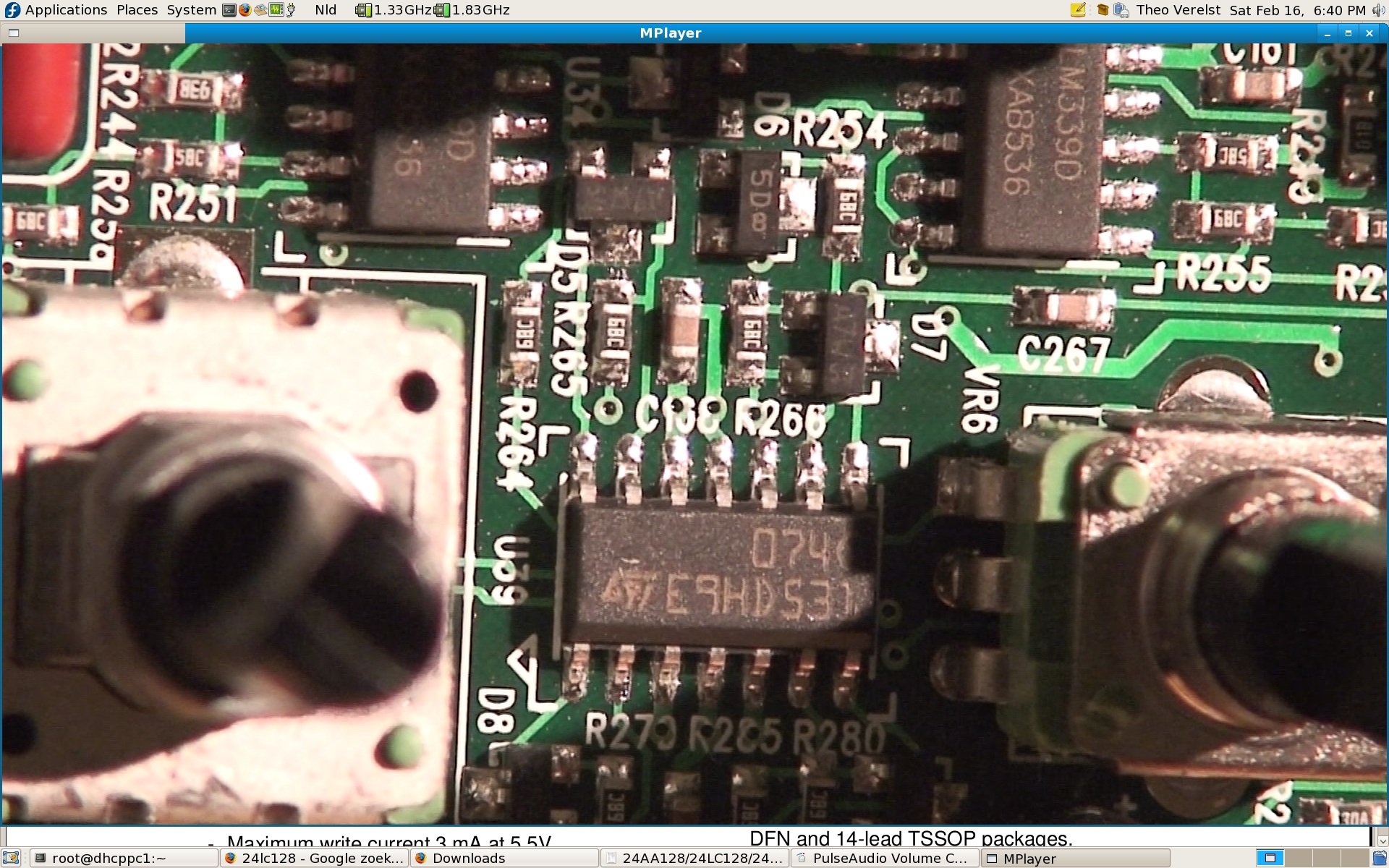
3D Is not a struggle at the fedora 8 notebook much because I installed
a driver which is enough from NVidia (although I think it came over
LIVNA repository) and I put on the very latest Gelato and the latest
Blender, which works great.
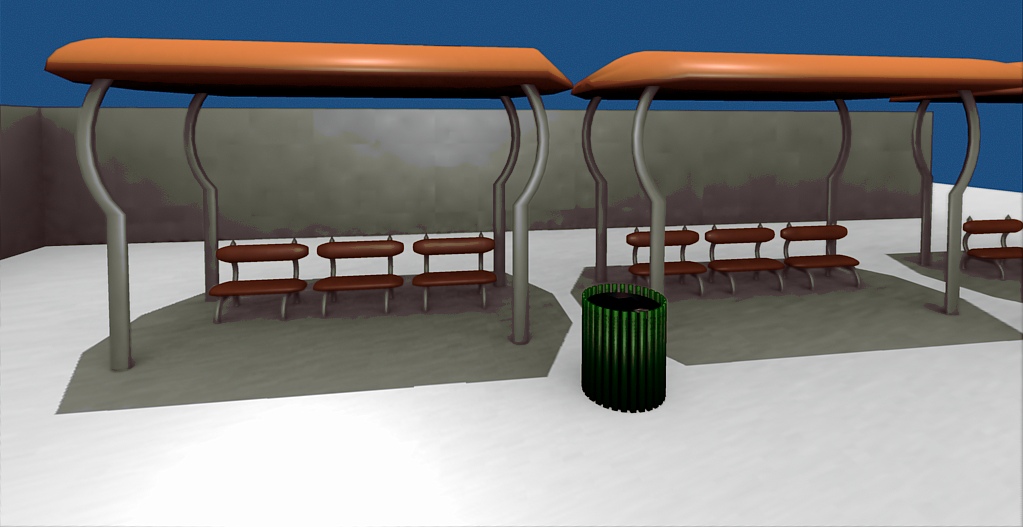
The above is an older gelato rendering of a web found model, the image
was onlyin 8 bits per colour but it looks kind of funny, and I
processed it a bit. Clearly it isn't rendered perfectly.
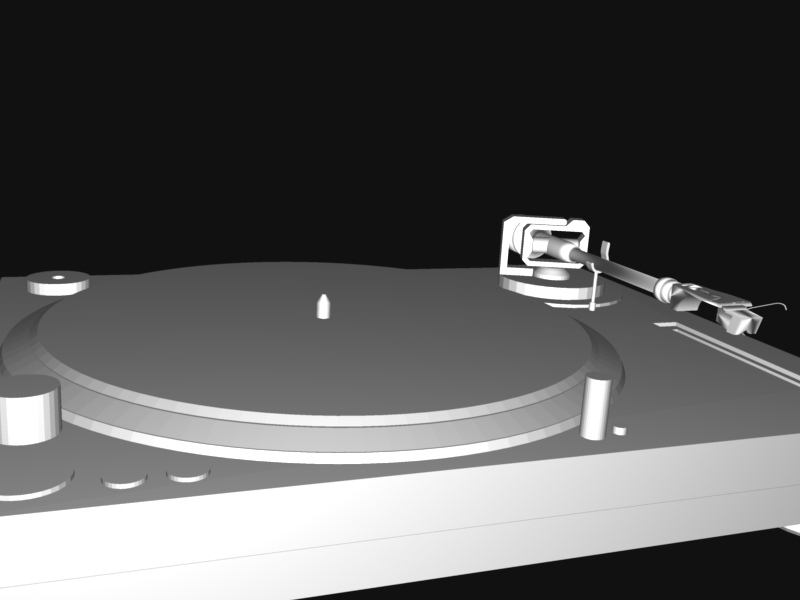


Oh and finally, regardless of wether I find the copper lead crack or
whatever it is with the lexicon, the pulseaudio matter is still a
struggle, but I have 3 heavy machines with the pulseaudio deamon
running, and some music software on, and jack and qjackctl and I
experimented a bit with the pulse/jack library which is a struggle and
the whole distributed audio/midi is still a total struggle, altough I
did get the distributed server to work by using a paplay command with
music from a file, that can be played from another machine with the 16
bit wav audio coming from another machine. The pulseaudio itself works,
with varying stability, the latency isn´t very long it seems, but
there are hickups, the pulseaudio live mix/volume controls aren´t
smooth on all machines that is some hold back when moved, and I am not
so sure the streams are as reliable and stable and therefore high
quality as the jack or espeically engenuity with jack I had on FC6. And
as noted, I didn´t yet get jackd to work with pulseaudio as a
whole setup. Maybe I should restart pulse after starting jack, with the
right startup script and then maybe with the right user ( su can do
that probably ) it should be possible to get pulse synced by jack and
it´s IO terminals visible in jack, and then hopefully the
broadcast UDP stream conversion would work too. I have restarted pulse
as another user I think and had loaded in jacl connectors, but that
setup didn´t get stable. It would be nice to know when audio
streams are sample converted, too, pulse can do that but I´m not
sure it sais when that happens, which is not straight enough for my
use. A clocked network interconnected system with one AD/DA would be OK
for now, for my uses. Although a well coupled set of DA converters is
cool for surround, but I don´t know if that would work.
Loudspeaker distortion!
Yeah! Well, uhm, no! Of course not! My spitzenreferenzklassesystem
shouldn´t have that of course. Well sorry, every loudspeaker
(even headphones) exhibits noticable distortion. Period. You could take
an expensive studio headphone or an expensive HiFi system from the
highest regions of the HiFiStereo maganize tests including exhorbitant
prices (like a 18.000 euros JBL Home Cinema speaker) and still if one
would take a good measurement microphone and for instance a decent
spectrum analyzer, distortion in electronics sense is easily
measurable, I´m sure. I mean I recall long ago already spectrum
analysers would have a dynamic range of 160dB, which implies an
accuracy of 8 decades or 0.000001 percent measurement accuracy, which
also is virtually never present in audio amplification, or DA
conversion. Honestly, it happens to be the case that my recent projects
(2 and 3-fold multiamped amplification systems) make use of a
preamplifier Operational Amplifier chip which at amplification 1 and 1
kHz and with everything working good (..) does come in the direction,
see the specified harmonic distortion in the relevant portion of the
datasheet which I quoted below (there´s even a free spice model
on the TI site):

From the BurrBrown /
Texas Instruments Datasheet of the OPA 627 OpAmp
But that is not the power amplifier needed to drive the speaker, or the
DA converter (even my fairly good reference being a Lexicon 24 bit
converter I recall has about a few thousandsth of a percent distortion
at a good frequency) because it is rare that these specifications are
electronically speaking hard to measure.
Speakers are known to generally speaking easily distort a few percent,
and then you ae really lucky. So speaking as an electronicist (which I
am also by education) ´duhhu´ :) . The types of distortion
of a speaker are different so it still makes sense to reduce all kinds
of electronics and digital distortion magnitudes because even with high
quality equipment, low distortion levels can still often easily be
perceived, although transient response and other issues like wire
resistance and grounding contribute, too.
That makes speakers still by far as they called in good audio books I
read as a kid in the seventies the weakest link in the audio
reproduction chain. Maybe room acoustics should be added, too. And
therefore probably the most rewarding components to improve, just like
spending half of a HiFi budget on speakers was supposed to reflect!
I use my own current speaker setup with pleasure and pride because they
work very good, even at times extremely good, depending on what
material I feed them, but even Guns ´n Roses from a (digital)
cable company media box from the VH1 channel with various coding and
(non-...) compressors working right can sound short of really great on
the system I use the most, which is great when combined with a good
beamer projecting faithfully on a large screen (106" diagonal, pro
grade).
This of course could be totally subjective, and also based on
coincidental results of audio materials with equipment, but I defy that
suggestion because that´s not how I made and improved the system,
and I did measure some things, and certainly used straight audio
sources to test it (like a Yamaha S90 synthesizer producing straight
sine waves over the whole audio range with it´s 20 bit DA
converter). I used measurement microphones with good preamps and
digital meter and a Audio Technica 2020 microphone and a very good
Lexicon preamp and 24 bit AD converter to measure some things in the
past, for instance to determine band limit frequencies for the 2 and 3
fold multi amping I use.
I would not acknowledge that I did extensive industrial grade dead room
testing of my setup, and for the 10 power amplifiers I rely on factory
distortion specifications from the chip datasheets, which are very
good: 0.005% THD at 1kHz @ 50 Watts RMS, and they are DC coupled amps
working like operational amplifiers with FET outputs, having wide
frequency range and good slew rate. I built the 4 way + sub speaker
system on the basis of a lot of know-how and component testing and they
behave a lot like I´d expected them to, so that I think is a good
sign, and I love to do the simplests tests of all: record or obtain
neutral materials and play them back to check for High Fidelity: when
it sounds really close to the original, without tricks, and similar
volume, the whole chain works good. So recording and playing back
voices, bird sounds, noises, bands and using neutrally recorded
material like Chesky audio CD and other recording with good microphones
and studio equipment I am at least satisfied that such test works
pretty good on my system.
In the context of speaker distortion I visited the dutch AES lecture
from Dr. Kippel from Germany recently which was about the measurement
equipment Kippel Gmbh produces and an analysis of speaker distortion
which concerns a 2d order approximation of various effects, of which he
clearly examplified inductance variation of the voice coil through
excursion and the maximum power which can be applied to a
speaker, especially at low frequencies during a distortion correction
using the aforementioned speaker model.
Honestly, it all sounded like (uhm) total crap (I mean for lets say a serious HiFi enthousiast), but that
I am sure that was because of the demo speakers being PA speakers and not intended as
studio reference or so. The estimated and exagerated distortion demo
was very clearly audible, and it was as I thought: 500 watss (as
claimed) on two fairly small PA speakers with I guess 2 8 inchers or so
per side just isn´t going to give you smooth and deep working
bass, those poor cones are too small even if you´d use a kilowatt
on them to move enough air! So Tracy Chapman even when distortion was
analysed and compensated somehow still sounded like coming from
resonating too small enclosures and only with hyped and not low
extending bass.
But the correction effect was very clear, and the equipment could
nicely measure cone excursion and impedance change as a consequence and
even small speakers were demonstrated which were measured to have very
slow return to centre characteristics and that was live-measured. I am
sure it would be cool to hook up my speaker setup to a good measurement
unit, but I am not sure what would happen with my closed but big
pressure encloseres with damping and the 4 speakers from 12 inch
through dome in them. Could be exiting to try, though I think I´d
also like a good (lets say a 20k$ HP) spectrum or wave analyser with
calibrated measurement pressure sensor and a good working dead room.
What a challenge. But they would I am SURE be able to amplify a signal
up to 10 Kilo Watts with the abovementioned distortion if you hand them
sufficient funding (lets say millions) and they feel like it. Yeah.
Great.
Anyhow the lecture I´m sure was very good at myth-busting
(I´d have prefered to have been in San Francisco to see it!) and
of course a lot of distortion of various kinds can be (automatically or
organised) found in all kinds of speakers and to measure and even
partially corrected: that is a good thing.
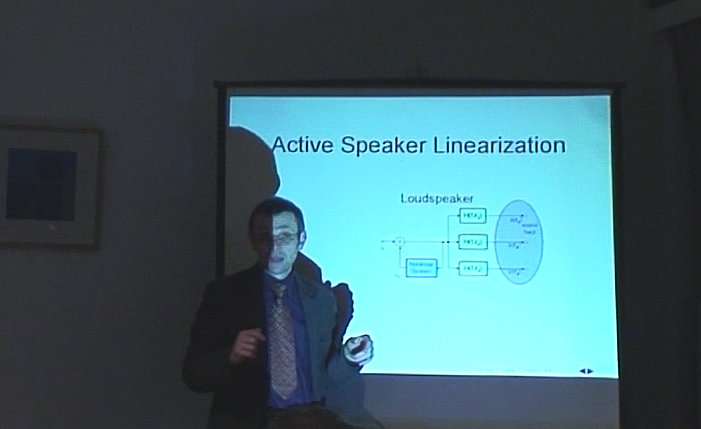
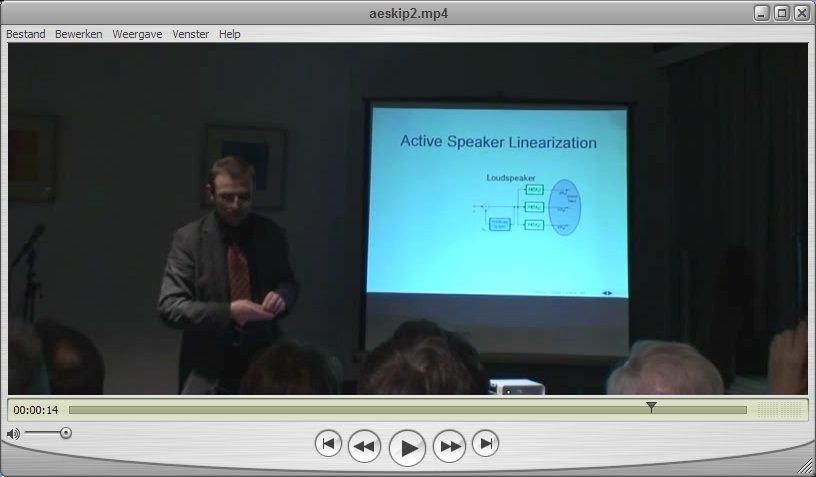
download: mpeg4 video ( 14 sec.,
3.4 MB )
The superwide (1:2.2 or so) format is chosen such that a Nokia
Communicator mobile phone with wide screen can exactly play this video,
and also the codec is correct for that phone, be sure to try if you
have one, this does NOT look like a cheesy ´phone movie´
(it was made with a HD camera) and the internet can let you download
this quality whereever you are and the player is able to let the whole
screen be used for movie playback. Beats CNN-mobile!
Of course like inthe screendump above a normal not too old PC can play
the file with Quicktime or mplayer without problems, too.
The original (16:9) HD recording is about 56 megabytes (if somebody
wants it it is here).
What would the Kippel equipment
cost...?
Redone Lecture Videos
Coding video and audio one always runs the risk the receivers can't
decode the most perfect or just possible version of compressed material
the maker came up with..
The example of Images applied to Music.
Well uhm, so can I afford to make such comparisons? Sure. I´m
more than enough editfied, talented and skilled in either, but it is
the big picture here I´m writing about because that is where
appearently everything new age is a big nasty taboo.
Lets say I cannot compare great 70´s posters, the Classical
Paintings, Dirty Harry (let´s say) and the whole of Rock, Jazz
and the better Pop (50s, 60s, 70s and 80s) in ANY WAY AT ALL with the
new age sh*. Sorry, no can do.
So comparisons of the
nonsense, the sin if you like and the Good Things are out of the
question, no matter how hard the rigged and uninteresting hit parade
tries "we have got to be taken serious...". It´s mamma´s
money only so who cares.
So it´s all about the money? I think money, power, fake
religions, patterns of the wrong kind (idolatry) from various sources
and of various implementation, and it starting to eat on many people
that that is showing and that a gouvernment of fear cannot stop the
realisation of such facts.
But for people in trouble or who must maybe even convert from adverse
and damagind views it may be important at times to consider Where It
All Comes From, and how certain worlds of sin and terror hold together,
and to get out: How Not.
House and rap ain´t cool, never have been. Hip hop is fascism,
which is not particularly interesting and certainly emotionally
straining. Rock was and is cool, and still is interesting after decades
while the New Age House was crumbling before it started and only
attracts real attention from mamma´s boys and deluded whores when
things are more normal. And Pedofiles, possibly, because they get
patterns to play with. And of course all the evil (as opposed to
´inclined to evil´) people and their organisation forms
have plotted for centuries to make as many people as possible take part
in the crime of the 20th century, to take over the good music with
devil (literally) inspired sh* which can be used to kill all that is
good and nice and worth while in the name of the beast (computers or
Europe, which ever would win I guess) or because of the great whore
from Rome with the more smalltime whores mothered under her waiting for
her punishment pimp, the beast.
Sounds stupid ? would to me, but also dramatic enough to have attention
for, so when I started to be convinced of biblical truths long ago I
sure paid attention to the big picture.
But Theo, the christians know all this, and manage the forgiveness just
fine! Motherf*. Sorry, I need that word, but I don´t want these
pages to be banned for undecent language, that don´t serve my
purpose. That is the sin of christians, like
Some of them that work forces (perform miracles) are the
same that burn crosses.
or
Yo, it´s just another bombtrack
and all the other great lyrics from "Rage against the machine" (The
beasts from the sea or the land which come up and go to perdition)
Holy roller lingo? No. Biblical language. So if you call me stupid or
wrong, especially as christian, than many people claim to believe in
the same, and as christian: I challenge you to put me straight,
seriously.
And I don´t really care, I don´t need the new age stuff, I
really don´t need anything they got. So they want the scraps and
the garbage form the real art and electronics, well, who cares. Their
problem, I don´t care. But the delusion of a lot of people
especially when they don´t live all to bad or just want normal
things bothers me, and I think I don´t want to meet or see the
implementations of the sh*. I don´t find it a pretty sight and a
hot one hundred filled with fascism and offence and scoffing makes me
sad.
Europe and Information Technology you said? Eh well, as opposed to Mary
and het little Lamb or so. I think that is what I just wrote,
isn´t it. Well, you may not say that! Oh, really, in the free
world?! Of course, imagine you´d say things that offend Our
Conservative (read ´satanist´) leaders! So what? I did all
the time already, won´t make much difference, won´t it! But
then if we agree we would suffer with you! Oh, is that is, am I
suffering, I though I just didn´t have money and everybody is
blackmailed all the time, sorry I understood wrong. So: I am suffering
and you guys are not up to it? Or, I´m better and y´all may
not admit the good things aren´t of the secret sneaky self
ascribed motherf* leaders ?
Hmm, lets get to some more meaningfull discussions usong content, such
like why are my image considerations comparable with the just brought
forward considerations and what is parallel to this in audio or music?
First of all the comparison is that both images and audio are probably
about art, and about things that many people like and influenced by.
That of course is a main target of what have we: wannabee world
leaders, the catholic hierarchy (dominicans and jesuits alike) and all
the religions following, the antichrist (I guess Hillary C. should
watch damien II) aka Nimrod (the big Negro ´man´ supposed
to help Cybile, the goddes of worse evils than I like to write about)
and all other big time organised badness threading the grass of normal
people.
Second: both subjects should live in freedom and both are terrorized
into submission and a purpose which is subdued to serving the
alledgedly to be evil rulers.
Third, there is a great desire, probably from the antichrist-likes and
the computermotherf*s (I think the word at least sais some truthfull
things about the actualities, I hear it was popular when the nazis were
fought, too) to include the subject of sampling and messing with
digital representations in both audio, samples and music alike, and
pictures, both moving and still.
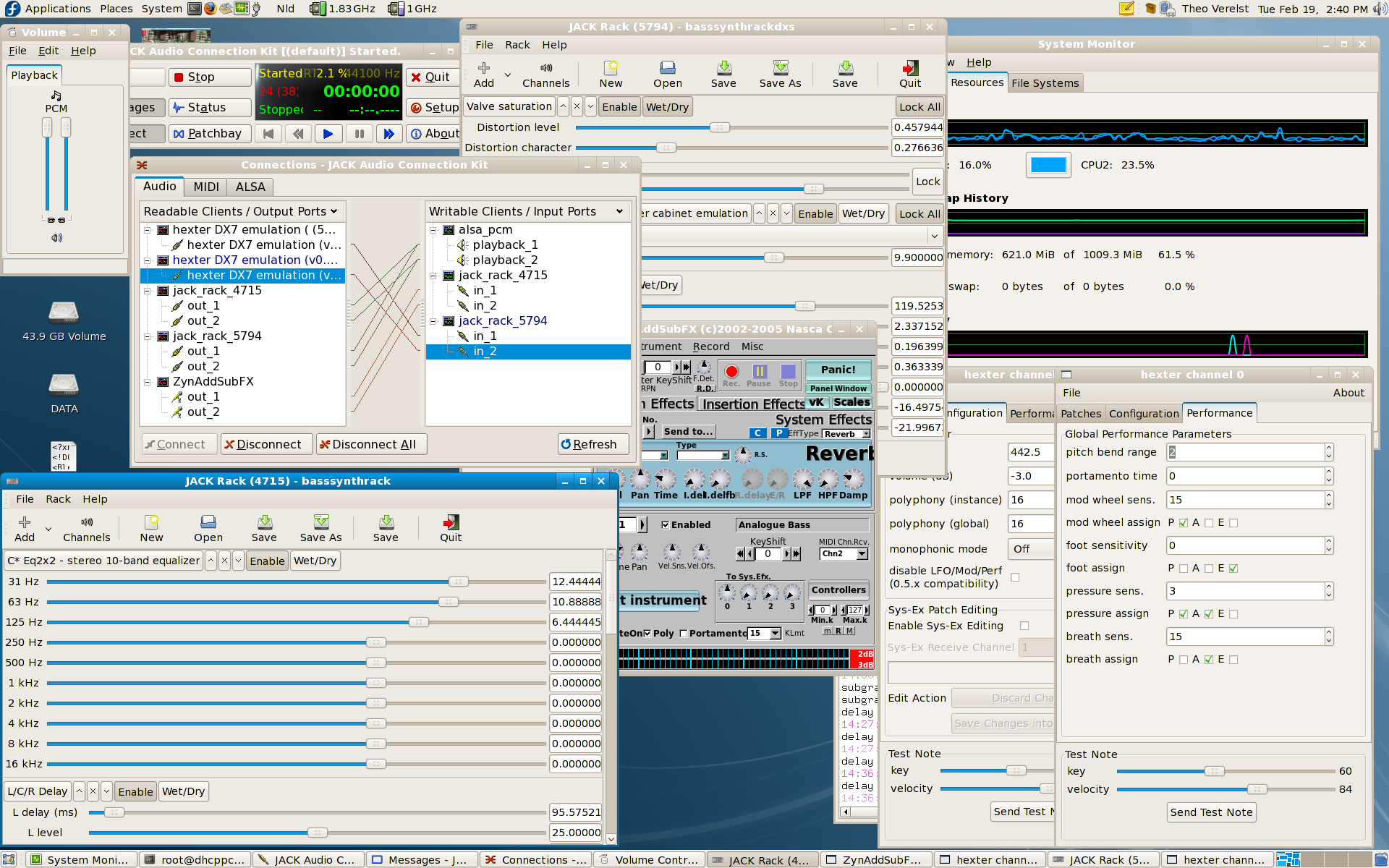
The above is a screen dump from a notebook making sounds, with good
quality thusfar from the lexicon 24 bit converter, and there is a fast
usb midi connection driving 2 DX7 simulators and an analog synth
simulation, with both sounds having their own effect rack to process
the sound with LADSPA effects connected over the JACK sounddeamon. That
is a lot of stuff! Sure, and it seems to work stable for hours and
certainly this didn't drain all the processor powers so that I added
rosegarden recording and made some small test recordings.
The next is a combination of softsynth sounds with LADSPA effects to do amplifier and speaker simulation, and reverb and tapped delay IIRC with some mixing
synthcombo mp3
wav (1 min 8)
The following
is a test in the context of the
Listen To Keyboards site,
which compares top synthesizers/keyboards in terms of some of the classic
sounds on them.
I did a bit of one of the pieces of music myself on a Yamaha S90
and compared the recorded wav (uncompressed CD quality audio) and the
mpeg compressed result.
pianosound mp3 wav (33 sec)
As I expected, even fairly high bitrate mp3 isn't anywhere near the
sensation of the wav file. Even on a good mobile phone, and especially on my big multiamped monitor prototypes with milage.
So any good records as a teen ager ? Sure.
These LPs I bought (or got as
present) (and had) myself from around 80 to about 85, LP´s mind
you, not recordings of, or inherited old albums or CD´s or music
cassettes. What a covers, compared with almost anything new (are
printers not so good anymore because they´re digital ?! Uuueeehm,
these are digitisations, aren´t they....):
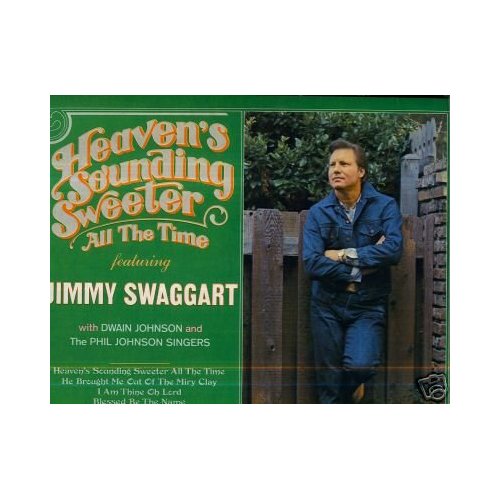
 Jimmy Swaggart "Live
from Nashville"
Jimmy Swaggart "Live
from Nashville"
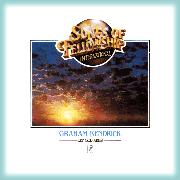 (Graham Kendrick, "Songs
of Fellowship": Let God Arise.)
(Graham Kendrick, "Songs
of Fellowship": Let God Arise.)
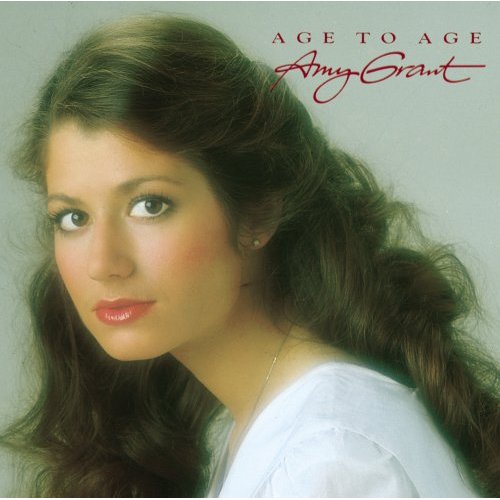 Amy grant, this one had
some absolutely great music, even jazz and some synthesizers.
Amy grant, this one had
some absolutely great music, even jazz and some synthesizers.
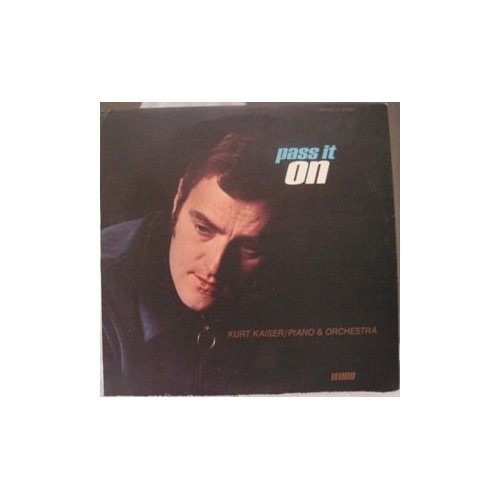 Kurt Kaiser. A guess buy which
worked out good, good piano playing with at least one piece which
should be considered a classic piano playing with I seem to recall bass
and drums with a sort of lyrical jazz like turn in it, probaly it was
the song Pass it On, first on second side.
Kurt Kaiser. A guess buy which
worked out good, good piano playing with at least one piece which
should be considered a classic piano playing with I seem to recall bass
and drums with a sort of lyrical jazz like turn in it, probaly it was
the song Pass it On, first on second side.
 Need I say more, I bought
this one together with a friend (to record it on
tape with good quality), on if the great works of their
classical rock, next to A Night At the Opera.
Need I say more, I bought
this one together with a friend (to record it on
tape with good quality), on if the great works of their
classical rock, next to A Night At the Opera.
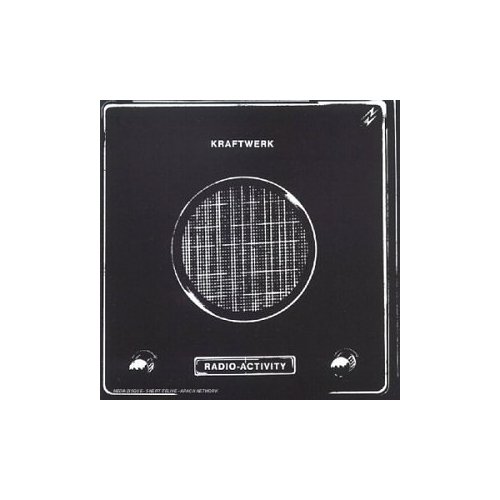 A lesser known but equally
good Kraftwerk synthesizer album. A great influence of mine in the 80s,
when I made my own music electronics.
A lesser known but equally
good Kraftwerk synthesizer album. A great influence of mine in the 80s,
when I made my own music electronics.
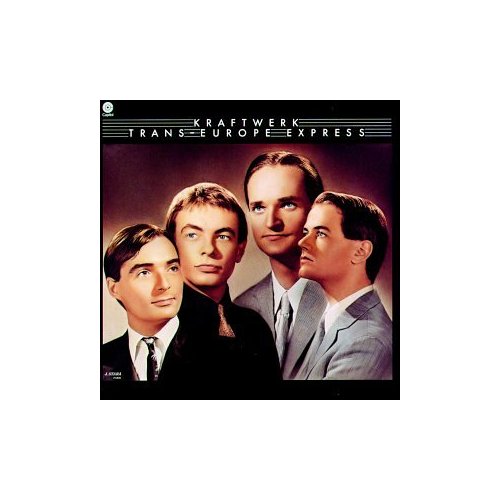 I think this must have been
after the 70s. Great work of art with the most challenging musical
instruments: synthesizers (and computer equipment to go with it).
I think this must have been
after the 70s. Great work of art with the most challenging musical
instruments: synthesizers (and computer equipment to go with it).
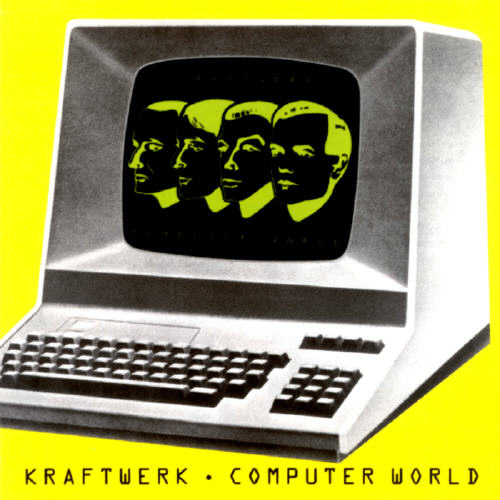 Probably the first LP I got for
my birthday, at my request. The guy who gave got a good copy too,
I´m sure.
Probably the first LP I got for
my birthday, at my request. The guy who gave got a good copy too,
I´m sure.
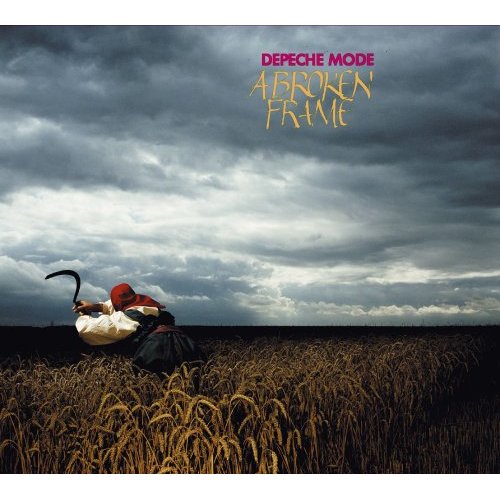 Probably an underestimated band,
they still make music, mainly or probably only with synthesizers (and drum
computers and sequencers and studio equipment). And the human voice. I
loved the music on this album, on a good system with CD player it
sounds great, too, probably mps don´t. Most well known "I just
can´t get enough", which iIrc was with emulators (sample
machines). I liked the analog stuff the best at the time, musical,
spacious, interesting, challenging (and not only rythmically).
Probably an underestimated band,
they still make music, mainly or probably only with synthesizers (and drum
computers and sequencers and studio equipment). And the human voice. I
loved the music on this album, on a good system with CD player it
sounds great, too, probably mps don´t. Most well known "I just
can´t get enough", which iIrc was with emulators (sample
machines). I liked the analog stuff the best at the time, musical,
spacious, interesting, challenging (and not only rythmically).
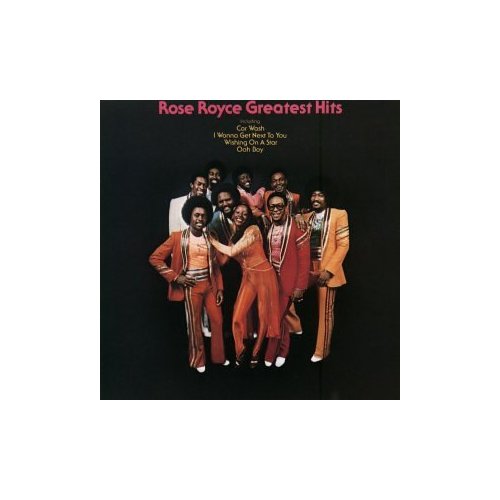 The best LP album I had myself?!
Possibly, depending on mood. I had made a good quality record player
and (self made) preamp, and this could funk my 2x70 Watts driven (self
made amp) speakers (self made) and room, and mind. Great music.
The best LP album I had myself?!
Possibly, depending on mood. I had made a good quality record player
and (self made) preamp, and this could funk my 2x70 Watts driven (self
made amp) speakers (self made) and room, and mind. Great music.
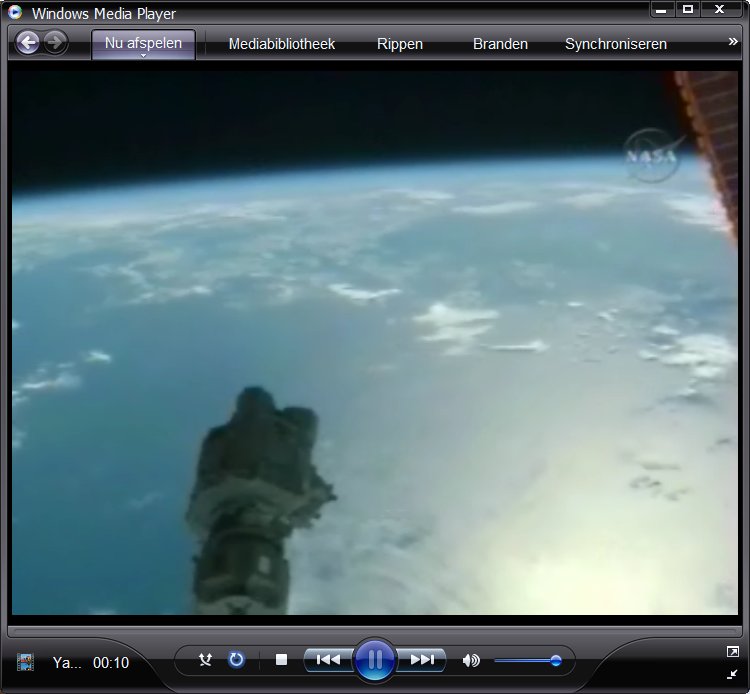
God's
view ?
(Old american TV voice
"You´ll find a pair of gloves, put them on.")

 Jimmy Swaggart "Live
from Nashville"
Jimmy Swaggart "Live
from Nashville"  (Graham Kendrick, "Songs
of Fellowship": Let God Arise.)
(Graham Kendrick, "Songs
of Fellowship": Let God Arise.) Amy grant, this one had
some absolutely great music, even jazz and some synthesizers.
Amy grant, this one had
some absolutely great music, even jazz and some synthesizers. Kurt Kaiser. A guess buy which
worked out good, good piano playing with at least one piece which
should be considered a classic piano playing with I seem to recall bass
and drums with a sort of lyrical jazz like turn in it, probaly it was
the song Pass it On, first on second side.
Kurt Kaiser. A guess buy which
worked out good, good piano playing with at least one piece which
should be considered a classic piano playing with I seem to recall bass
and drums with a sort of lyrical jazz like turn in it, probaly it was
the song Pass it On, first on second side. Need I say more, I bought
this one together with a friend (to record it on
tape with good quality), on if the great works of their
classical rock, next to A Night At the Opera.
Need I say more, I bought
this one together with a friend (to record it on
tape with good quality), on if the great works of their
classical rock, next to A Night At the Opera. A lesser known but equally
good Kraftwerk synthesizer album. A great influence of mine in the 80s,
when I made my own music electronics.
A lesser known but equally
good Kraftwerk synthesizer album. A great influence of mine in the 80s,
when I made my own music electronics. I think this must have been
after the 70s. Great work of art with the most challenging musical
instruments: synthesizers (and computer equipment to go with it).
I think this must have been
after the 70s. Great work of art with the most challenging musical
instruments: synthesizers (and computer equipment to go with it). Probably the first LP I got for
my birthday, at my request. The guy who gave got a good copy too,
I´m sure.
Probably the first LP I got for
my birthday, at my request. The guy who gave got a good copy too,
I´m sure. Probably an underestimated band,
they still make music, mainly or probably only with synthesizers (and drum
computers and sequencers and studio equipment). And the human voice. I
loved the music on this album, on a good system with CD player it
sounds great, too, probably mps don´t. Most well known "I just
can´t get enough", which iIrc was with emulators (sample
machines). I liked the analog stuff the best at the time, musical,
spacious, interesting, challenging (and not only rythmically).
Probably an underestimated band,
they still make music, mainly or probably only with synthesizers (and drum
computers and sequencers and studio equipment). And the human voice. I
loved the music on this album, on a good system with CD player it
sounds great, too, probably mps don´t. Most well known "I just
can´t get enough", which iIrc was with emulators (sample
machines). I liked the analog stuff the best at the time, musical,
spacious, interesting, challenging (and not only rythmically). The best LP album I had myself?!
Possibly, depending on mood. I had made a good quality record player
and (self made) preamp, and this could funk my 2x70 Watts driven (self
made amp) speakers (self made) and room, and mind. Great music.
The best LP album I had myself?!
Possibly, depending on mood. I had made a good quality record player
and (self made) preamp, and this could funk my 2x70 Watts driven (self
made amp) speakers (self made) and room, and mind. Great music.


















































